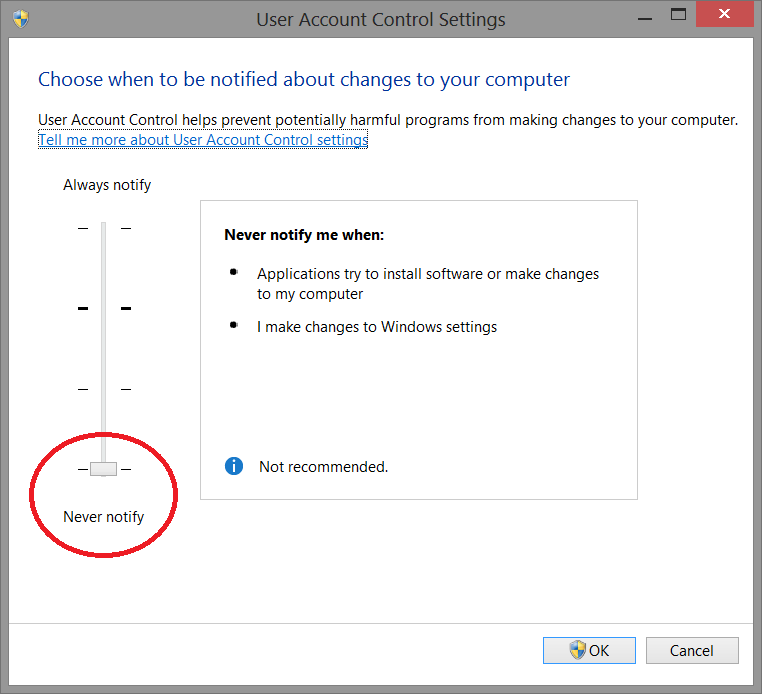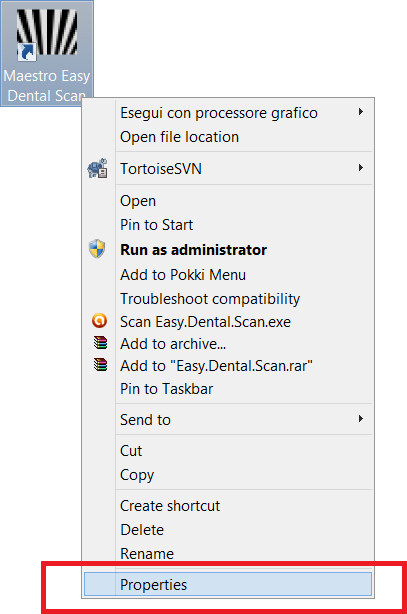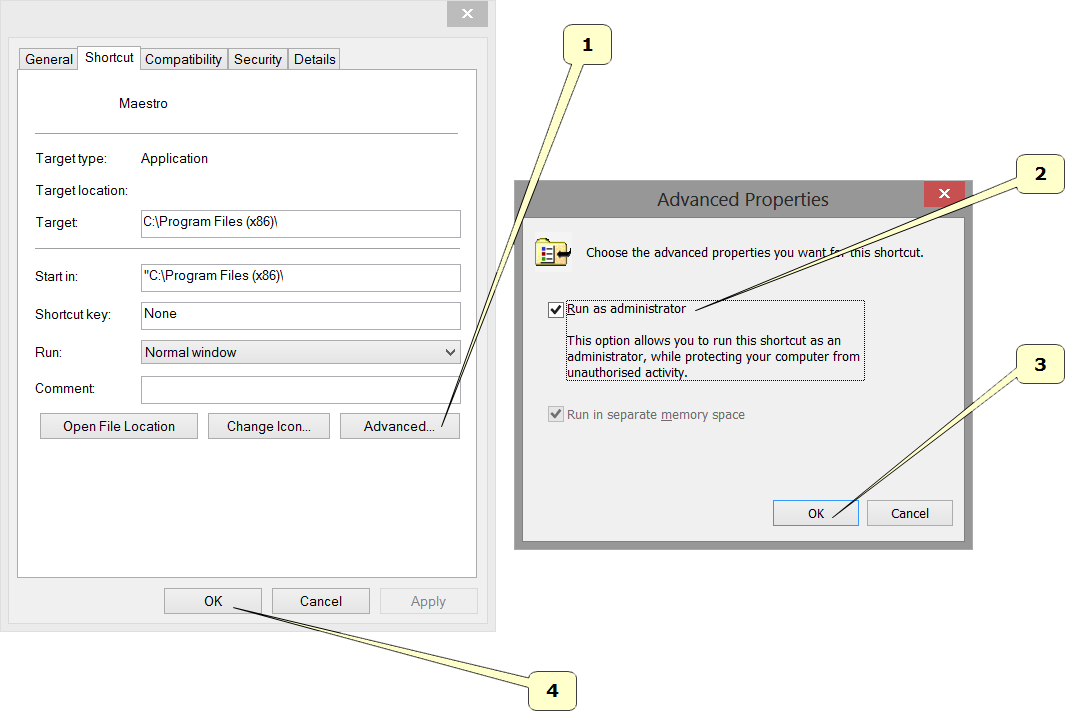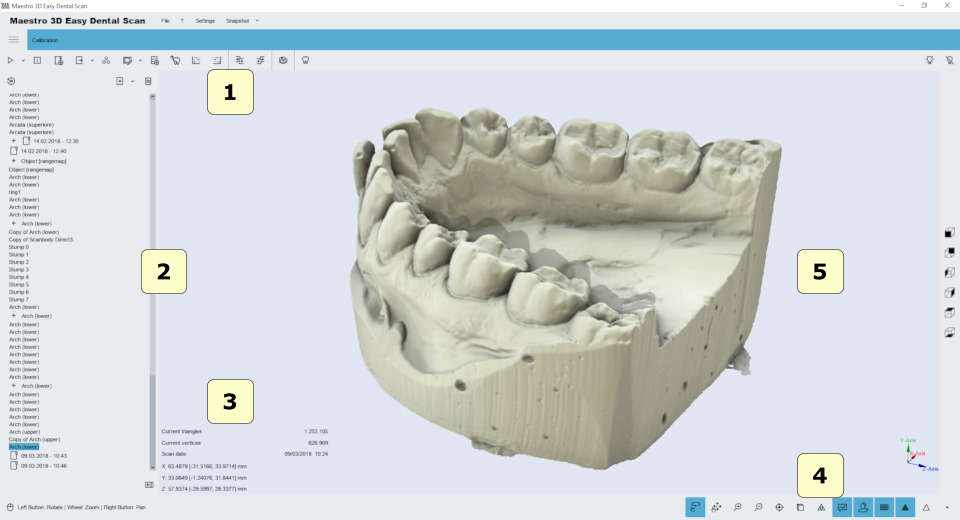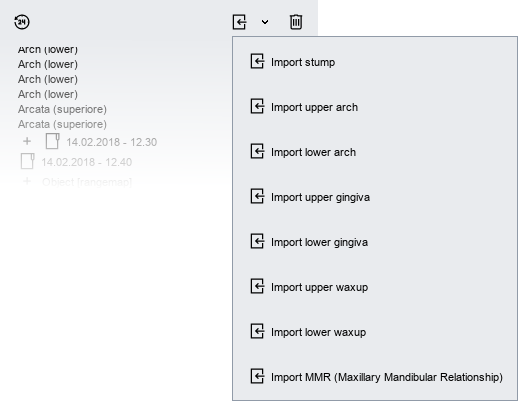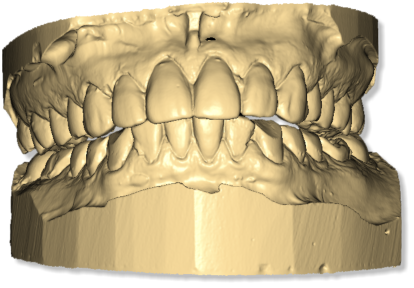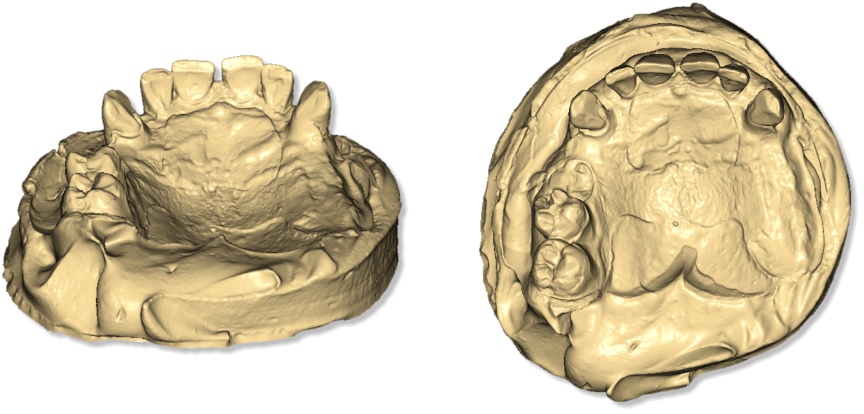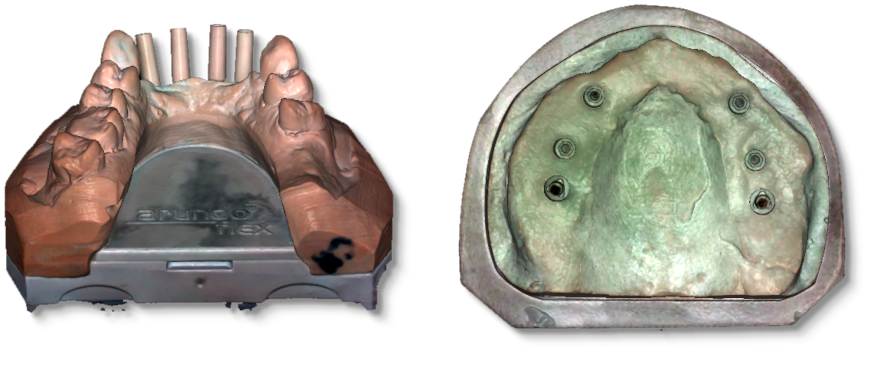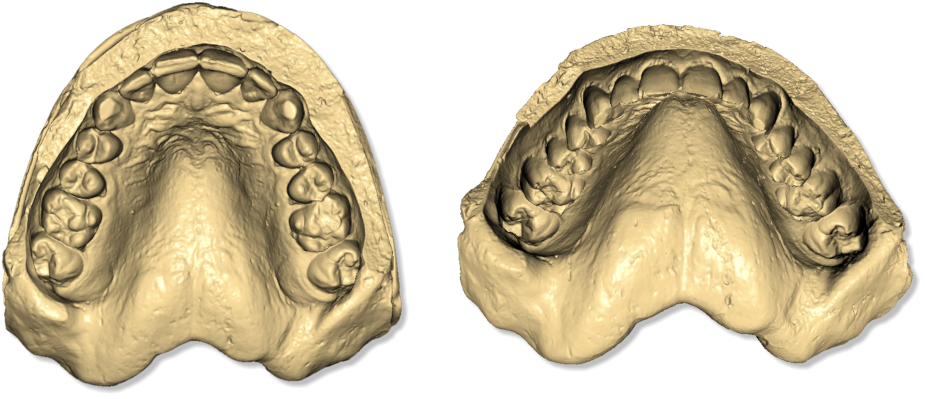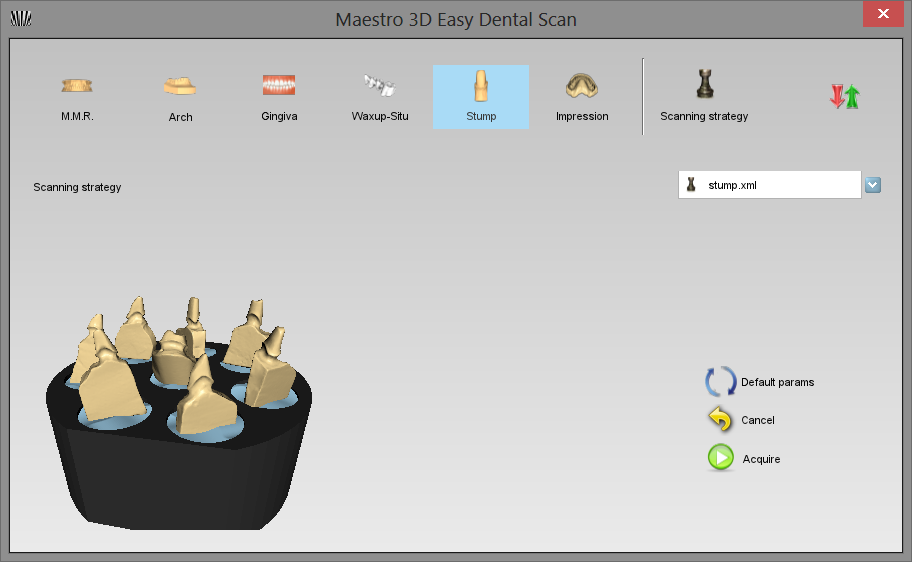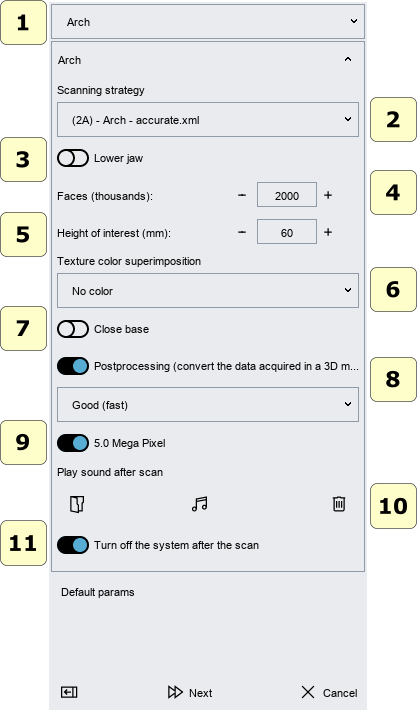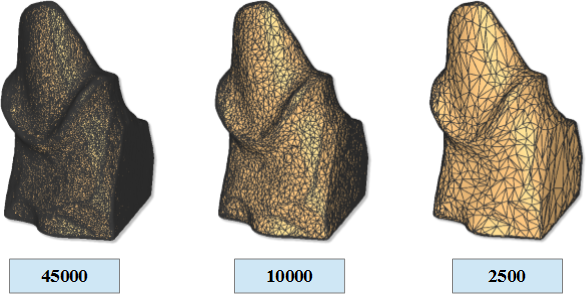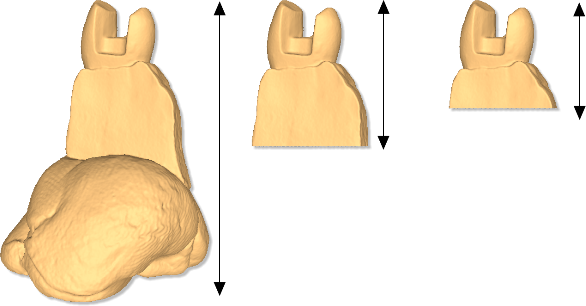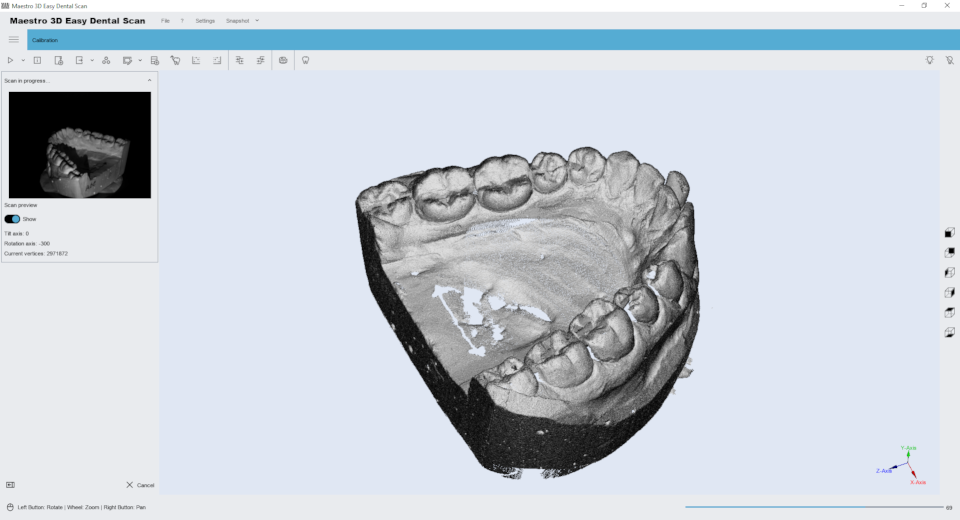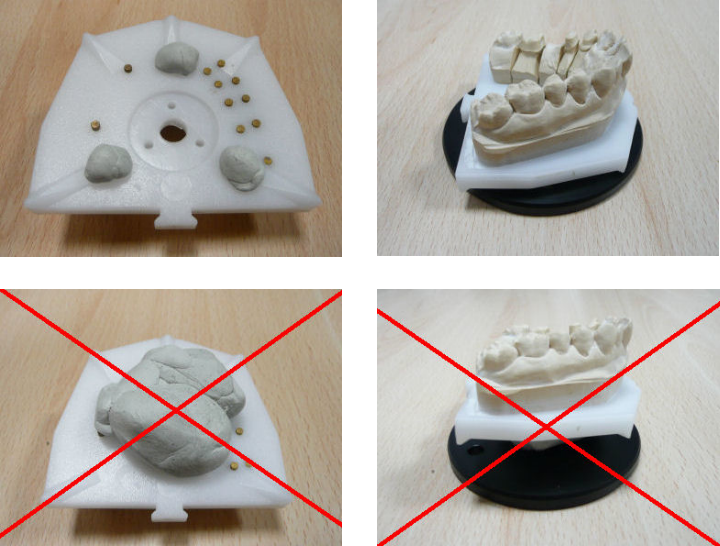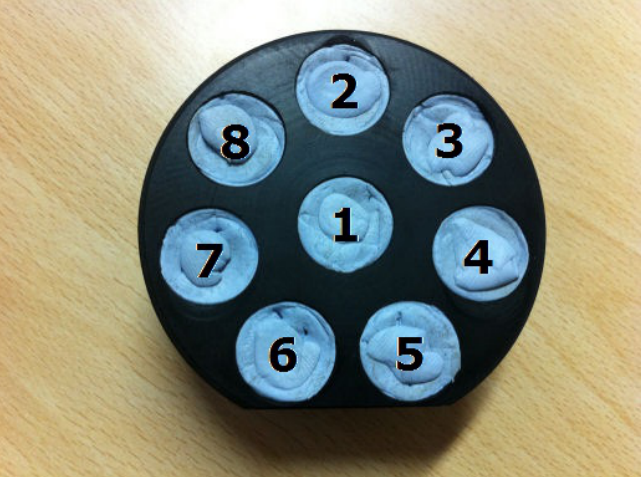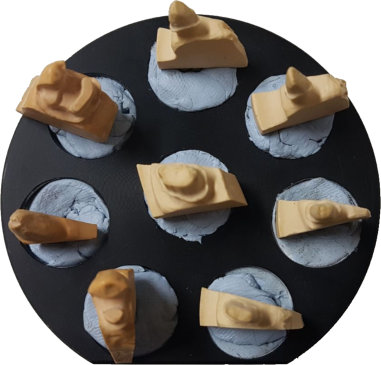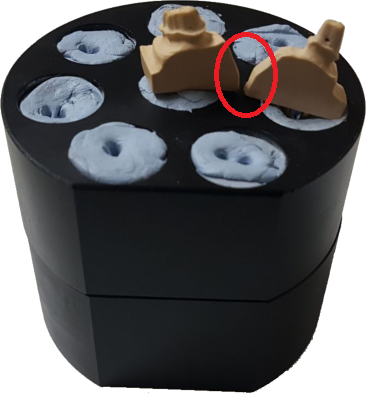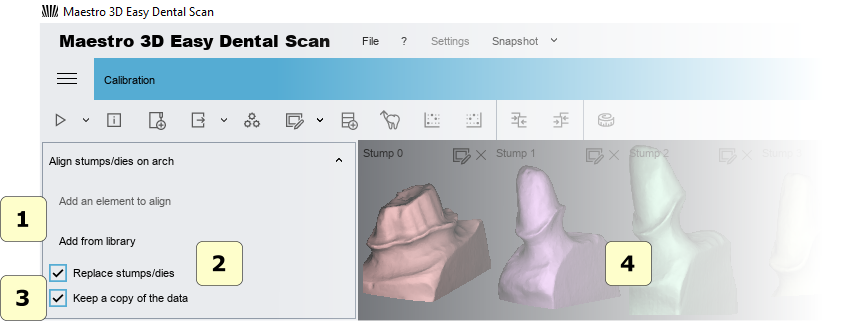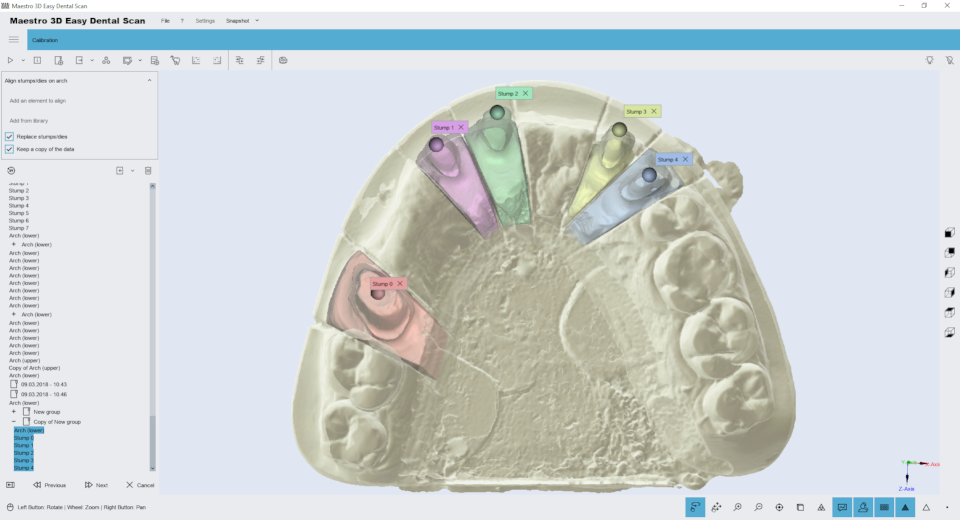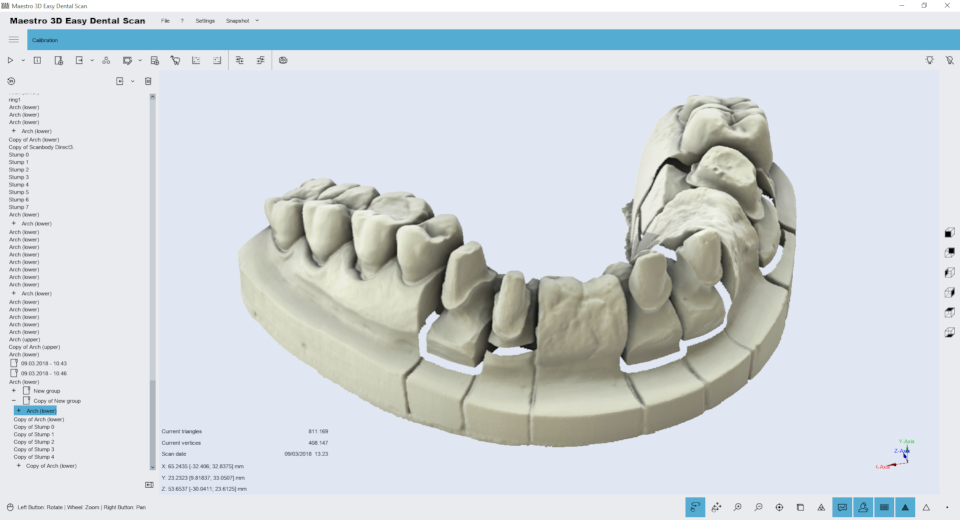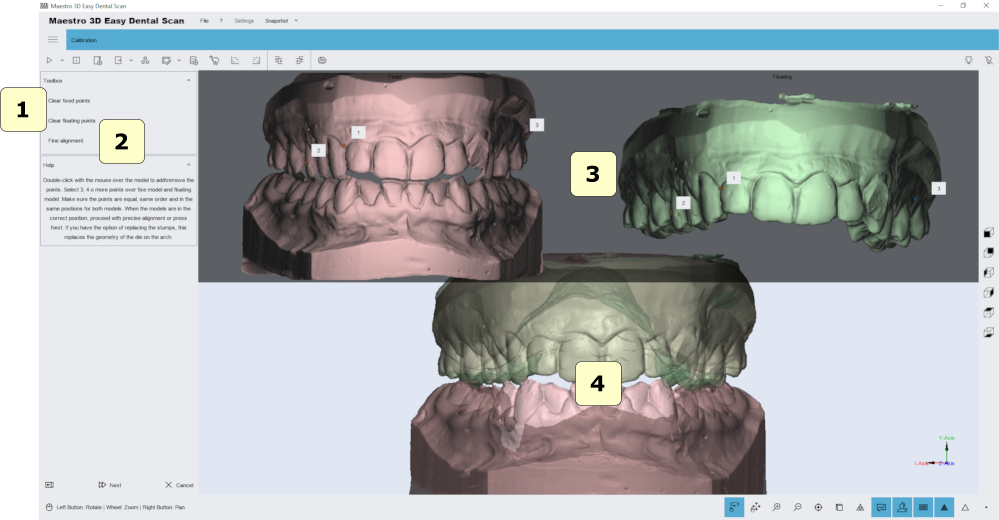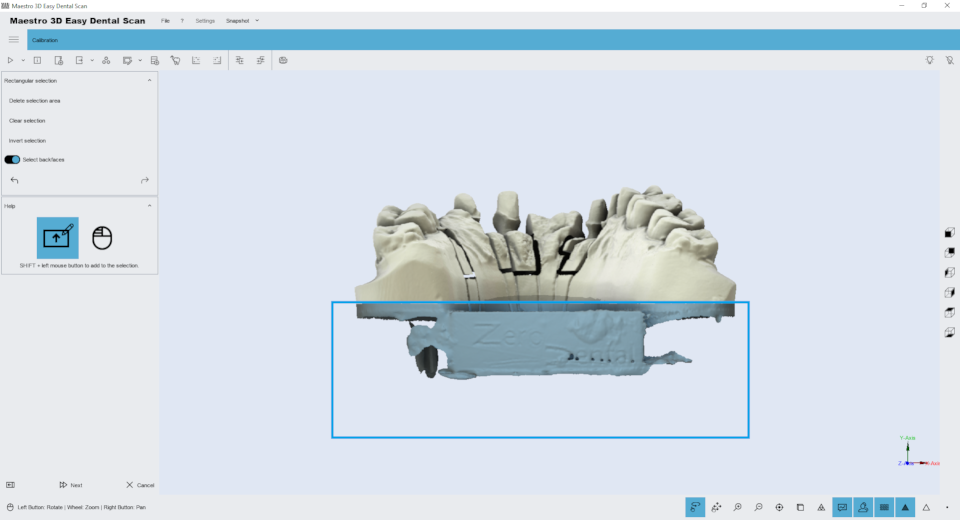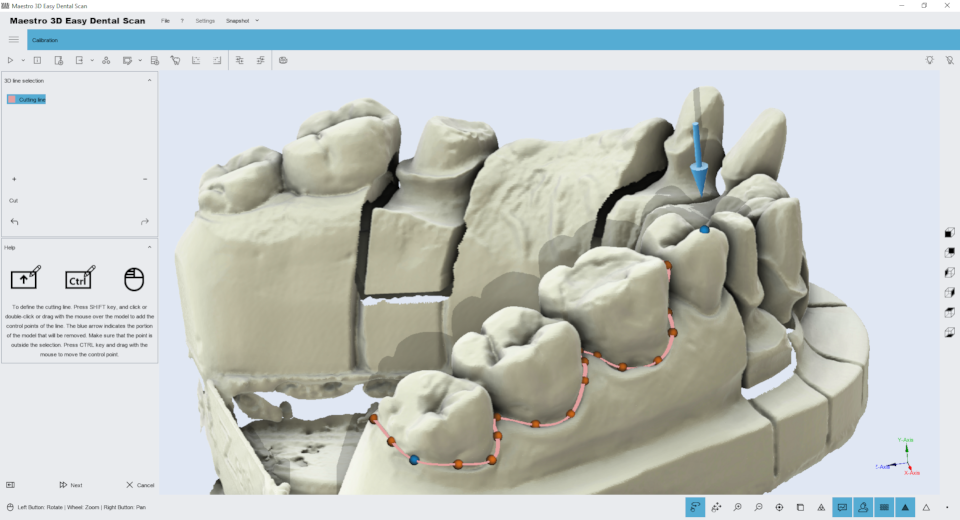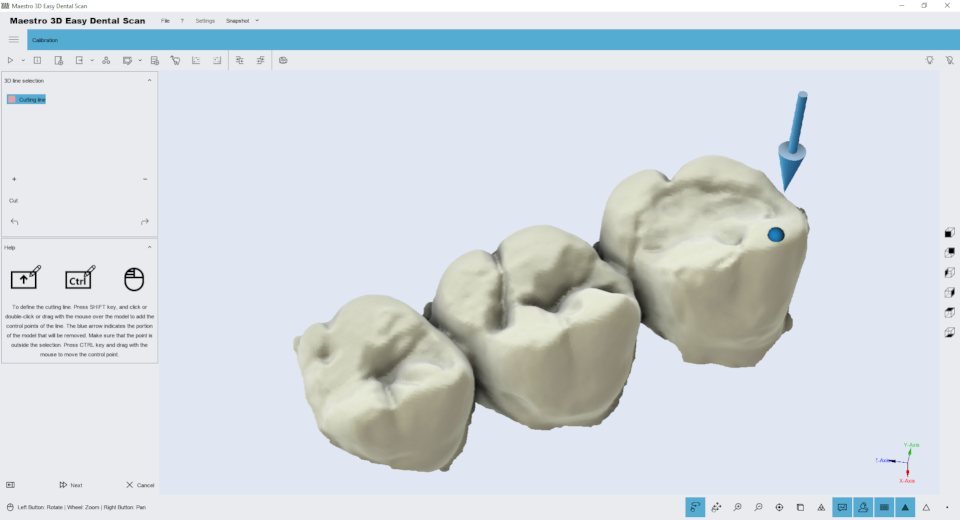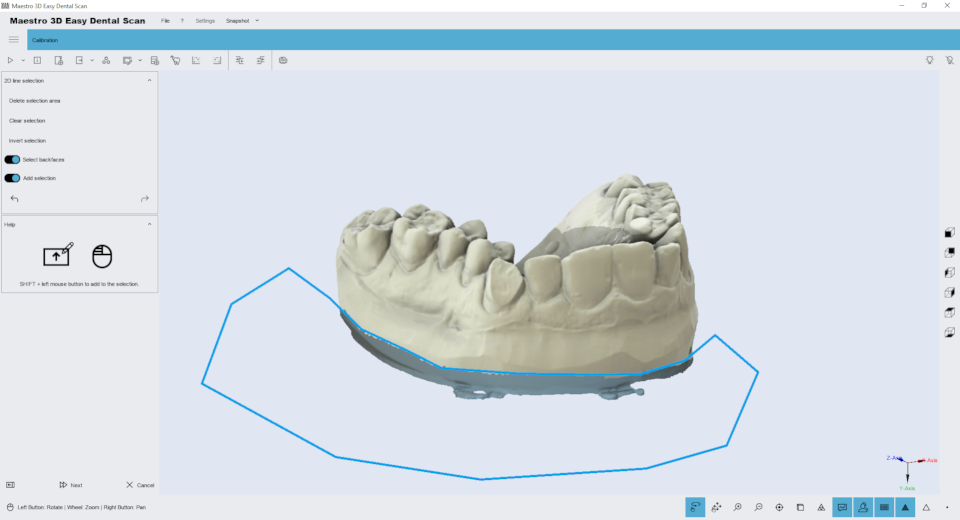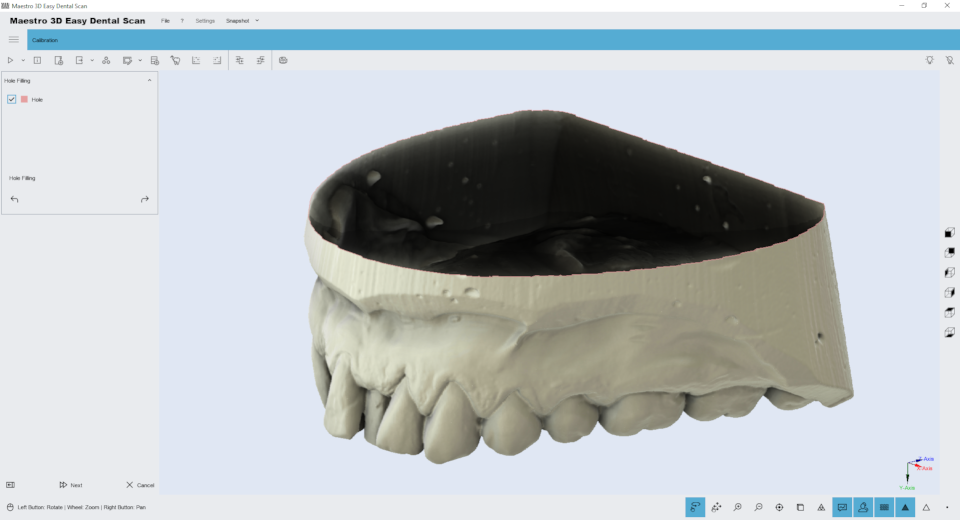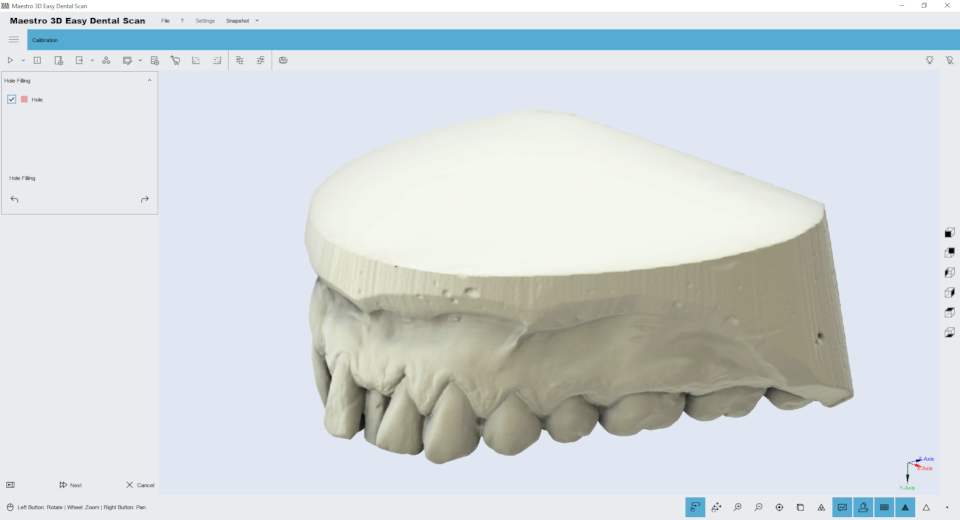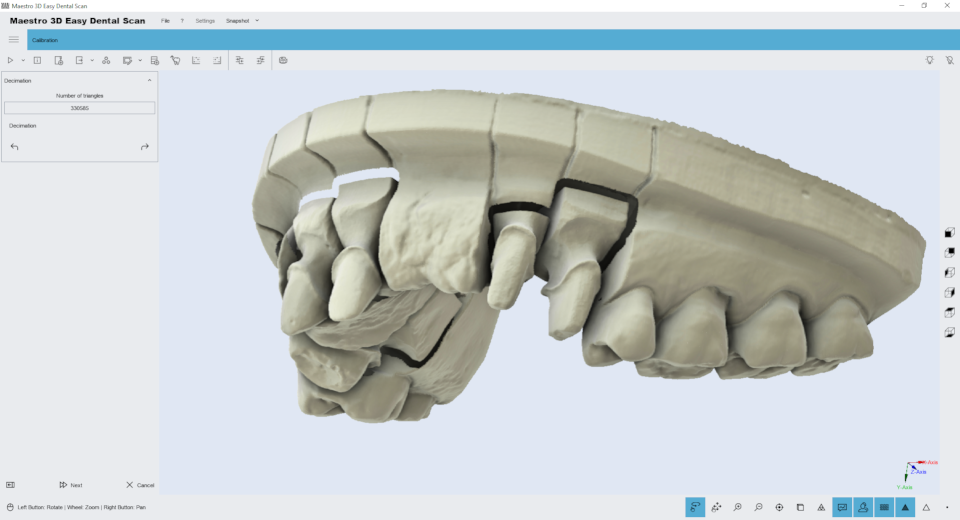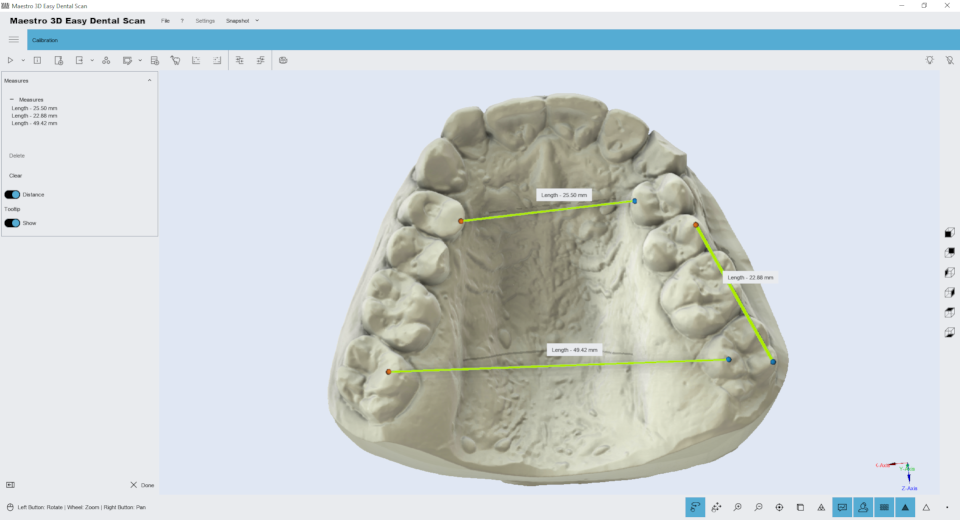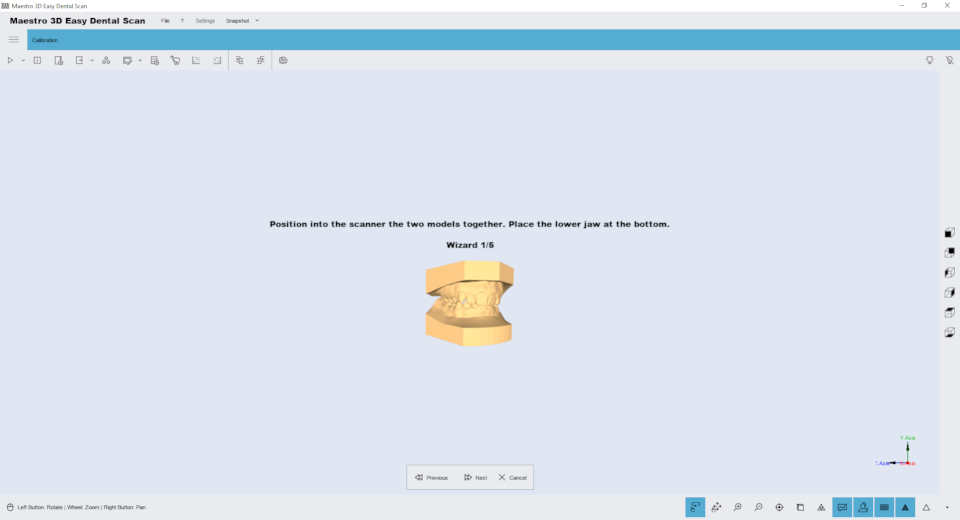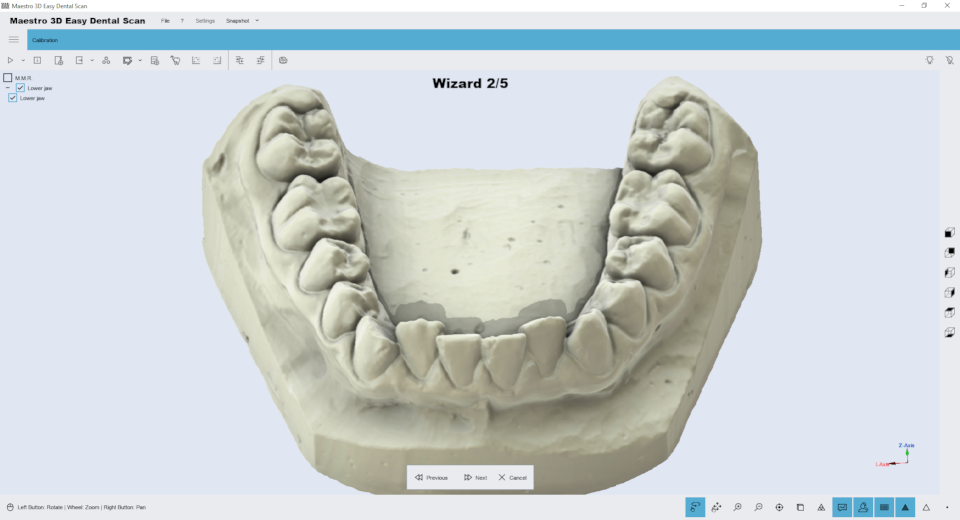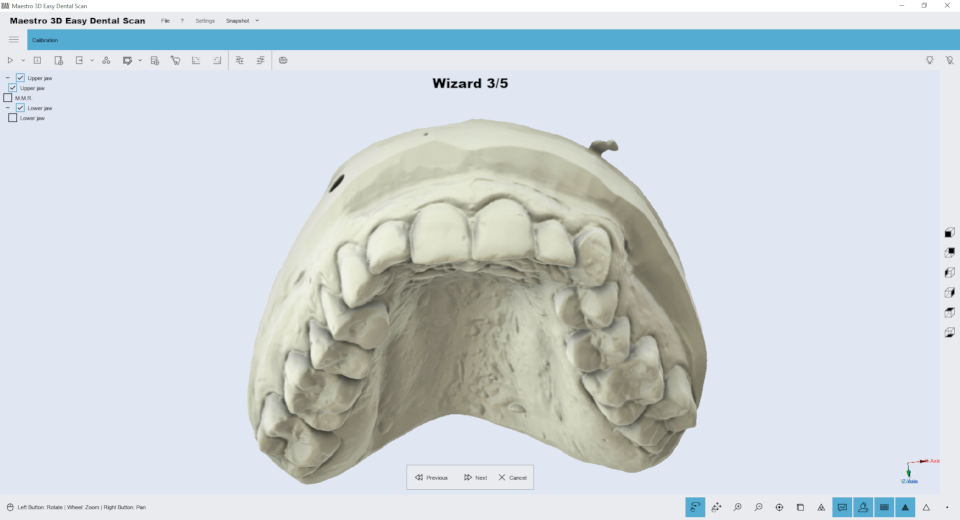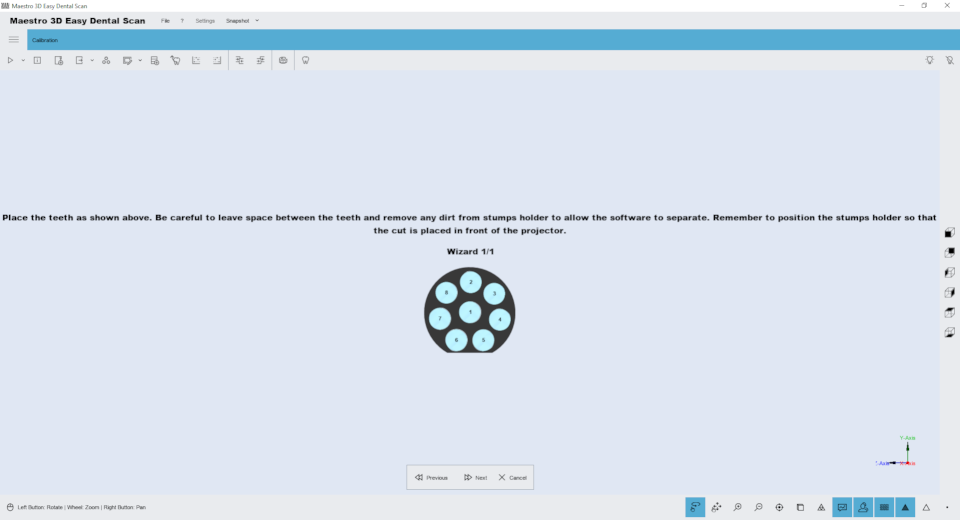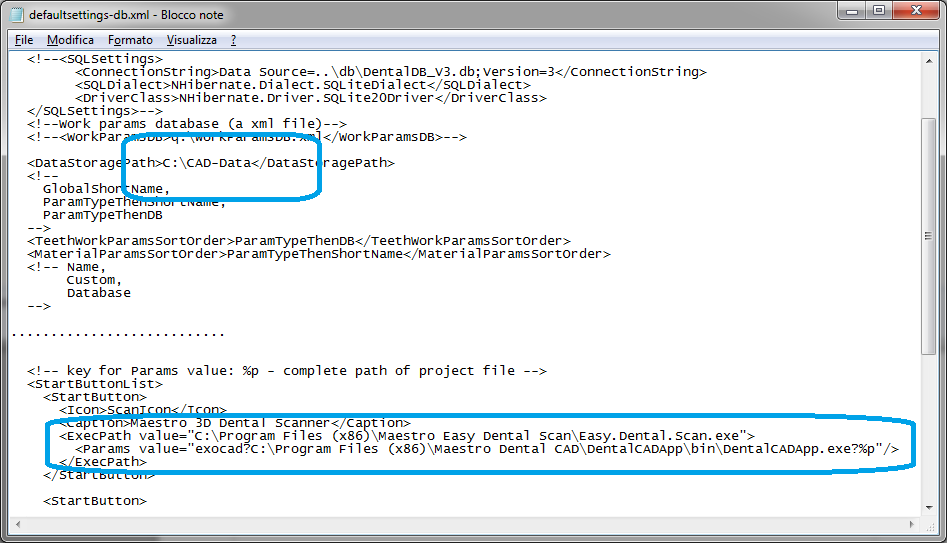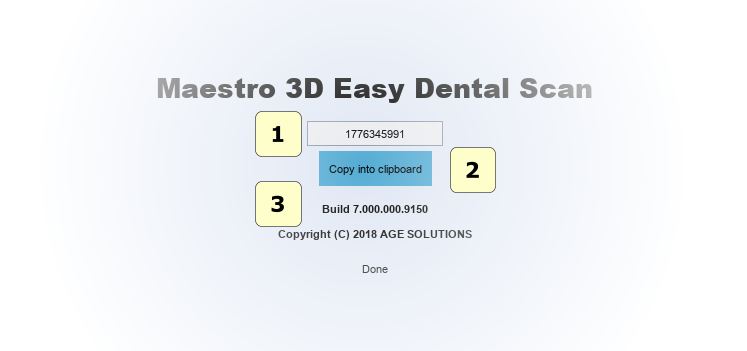Maestro 3D Easy Dental Scan - Manuale Utente
(→Interfaccia Utente) |
|||
| Line 1: | Line 1: | ||
| − | == | + | == Introduction to the use of Maestro 3D Easy Dental Scan software== |
<div align="justify"> | <div align="justify"> | ||
| − | Maestro | + | The aim of this document is to introduce the user to the use of the Easy Dental Scan Software, in a simple and quick way. Please read this manual carefully before making use of the Easy Dental Scan Software. |
| − | + | Maestro Easy Dental Scan is the software that combines with the line of Maestro 3D dental scanners. The software allows automatic acquisition of the dental objects with one click and creation of 3D surfaces of the acquired data entirely automatic, without any user intervention. The innovative software guarantees exceptional performances, fully exploiting the parallel calculation offered by the most recent multicore and multithreading technologies available on the market. | |
| − | + | ||
| − | + | ||
| Line 11: | Line 9: | ||
</div> | </div> | ||
| − | == | + | == UAC - User Account Control == |
| + | <div align="justify"> | ||
| + | To avoid difficulties and limitations in the use of the Software, it is necessary to set the UAC slider - User Account Control to the minimum value as shown in the picture below. | ||
| − | + | To log in to the setting window: Control panel-> User Account-> Change Settings User Account Control. | |
| − | + | ||
| − | |||
| − | |||
| − | |||
| − | |||
| − | |||
<div align="center"> [[image:UAC.png]] </div> | <div align="center"> [[image:UAC.png]] </div> | ||
| + | |||
</div> | </div> | ||
| − | + | == Administrator's Rights == | |
| − | == | + | |
<div align="justify"> | <div align="justify"> | ||
| − | + | In order yo put in operation the Software it is necessary to set correctly administrator's rights. | |
| − | + | Follow the instructions as shown in the pictures below. | |
| − | + | Right button of the mouse on the Software's icon to start the contextual menu and select the entry '''properties'''. | |
| + | <div align="center"> [[image:administrator.rights.eds.png]] </div> | ||
| − | |||
| − | + | Follow the steps as shown in the sequency from 1 to 4. | |
| − | + | ||
| Line 51: | Line 44: | ||
| − | * | + | * Press the button '''Advanced.''' |
| − | * | + | * Select the voice '''Run as administrator.''' |
| − | * | + | * Press the button '''Ok.''' |
| − | * | + | * Press the button '''Ok.''' |
| + | |||
</div> | </div> | ||
| − | == | + | == User Interface == |
<div align="justify"> | <div align="justify"> | ||
| − | + | The figure below shows the composition of the user interface. | |
| Line 67: | Line 61: | ||
| − | * '''1)''' Toolbar | + | * '''1)''' Main Toolbar. |
* '''2)''' Tree Area. | * '''2)''' Tree Area. | ||
| − | * '''3)''' Area | + | * '''3)''' Info Area. |
| − | * '''4)''' | + | * '''4)''' Bottom Area. |
| − | * '''5)''' Area | + | * '''5)''' Visualization\Editing Area |
</div> | </div> | ||
| − | === Toolbar | + | === Main Toolbar === |
<div align="justify"> | <div align="justify"> | ||
| − | + | The main toolbar allows the access to all functionalities of Easy Dental Scan Software. | |
| Line 86: | Line 80: | ||
| − | * '''1)''' '' | + | * '''1)''' [[image:Scan.play32.png]] ''New Acquisition'' - Start a new scan. |
| − | * '''2)''' '' | + | * '''2)''' [[image:Info32.png]] ''Scanner Status'' - Activates the window that monitors the hardware scanner status. |
| − | * '''3)''' '' | + | * '''3)''' [[image:Add.group32.png]] ''New Group'' - Adds a new group in the tree. It's possible to move the elements of the tree inside/outside a group by mouse drag and drop. |
| − | * '''4)''' '' | + | * '''4)''' ''Export (Z Axis)'' - Export the selected item along the Z Axis. You can also select the option ''Export (Y Axis).'' |
| − | * '''5)''' '' | + | * '''5)''' ''Postprocess (convert scanned data into a 3D model)'' - The function is enabled when an item is selected not postprocessed. This operation can take a few minutes to converts the scanned data from the scanner in a triangular geometry. |
| − | * '''6)''' '' | + | * '''6)''' ''Editing filter'' - Edit the selected items. This is useful for removing artifacts due to scanning, to remove the putty scanned, for make the holefilling, the decimation, 2D\3D selection edit, etc. |
| − | * | + | ** [[image:Edit.ico32.png]] [[#Editing_with_2D_rectangle|Editing with 2D rectangle]] |
| − | * | + | ** [[image:Free.hand32.png]] [[#Editing_with_3D_polyline|Editing with 3D polyline]] |
| − | ** | + | ** [[image:Selection.blu.32.png]] [[#Editing_with_2D_selection|Editing with 2D selection]] |
| − | ** | + | ** [[image:Hf32.png]] [[#Holefilling|Holefilling]] |
| − | * | + | ** [[image:Decimation32.png]] [[#Decimation|Decimation]] |
| − | * | + | * '''7)''' ''Import a scanbody from library''. |
| − | ** | + | * '''8)''' ''Align dies on arch'' - automatic alignment procedure of the stumps. |
| − | * ''' | + | * '''9)''' Manual alignment. |
| − | * ''' | + | ** [[image:321.align.fix32.png]] ''Manual align 3-2-1 - Set Fixed item'' - Set the selected item as fixed in the manual align procedure. |
| − | * ''' | + | ** [[image:321.align.mov32.png]] ''Manual align 3-2-1 - Set Floating item'' - Set the selected item as floating in the manual align procedure. |
| − | ** | + | * '''10)''' [[image:Measures32.png]] [[#Free_Measures|Free Measures]]: |
| − | + | ** point-point measures. | |
| − | + | ** angle measures. | |
| − | + | ||
| − | ** | + | |
| − | + | ||
| − | * ''' | + | |
| − | ** | + | |
| − | ** | + | |
| − | + | ||
| − | + | * '''11)''' ''CAD'' - send selected items to the CAD software. | |
| + | * '''12)''' Views: | ||
| + | ** ''front view''. | ||
| + | ** ''rear view''. | ||
| + | ** ''right side view''. | ||
| + | ** ''left side view''. | ||
| + | ** ''top view''. | ||
| + | ** ''bottom view''. | ||
| + | * '''13)''' Projector status. | ||
| + | ** [[image:PowerOn32.png]] ''Power on''. | ||
| + | ** [[image:PowerOff32.png]] ''Power off''. | ||
| + | * '''14)''' [[image:Exit32.png]] ''Exit''. | ||
| − | |||
| + | The calibration tab is described here: [[Maestro_3D_Dental_Scanner_-_Calibration|Calibration.]] | ||
| + | |||
| + | |||
| + | |||
| + | </div> | ||
| + | |||
| + | === Bottom Toolbar === | ||
<div align="justify"> | <div align="justify"> | ||
| − | + | The bottom toolbar is the area of the screen containing a progress bar that is displayed and updated during each computation of the program and the controls for changing the visual settings of the visualization/editing area. | |
| + | |||
| Line 125: | Line 130: | ||
| − | * '''1)''' | + | * '''1)''' magnify in [Key PGDown]/magnify out [Key PGUp]. |
| − | * '''2)''' | + | * '''2)''' show/hide trackball. |
| − | * '''3)''' | + | * '''3)''' reset trackball [Key R]. |
| − | * '''4)''' | + | * '''4)''' parallel projection [Key O], perspective projection [Key P]. |
* '''5)''' smooth shading [Key S], flat shading [Key F]. | * '''5)''' smooth shading [Key S], flat shading [Key F]. | ||
| − | * '''6)''' | + | * '''6)''' show/hide triangles, edges [Key E], vertices [Key V]. |
| + | </div> | ||
| + | === Visualization / Editing Area and Info Area === | ||
| + | <div align="justify"> | ||
| + | The visualization / editing area is the area of the window in which the models are visualized and all the editing operations are performed. | ||
| − | + | In the visualization area it is possible to see the models and edit and measure distance between different point. | |
| − | + | In order to examine the models displayed in the visualization / editing area camera parameters (position, scale and rotation) can be setted using an instrument called trackball. | |
| − | + | The trackball is very simple to use. Just use the Left mouse button dragging to rotate around the model, the mouse wheel to Zoom in / Zoom out and the Right mouse dragging to move (pan) the camera. | |
| − | + | ||
| − | + | The info area of the screen shows the info related to the current item. | |
| − | |||
</div> | </div> | ||
| − | |||
=== Tree Area === | === Tree Area === | ||
<div align="justify"> | <div align="justify"> | ||
| − | + | The Tree Area contains all the models scanned. The Tree Area organization has a tree. The use of groups allows you to keep an ordering of the models scanned. | |
| − | + | To select a model from the Tree Area just click on it with the left mouse button. The models selected will be displayed on Visualization Area. To select more models click by holding down the CTRL\SHIFT key. | |
| − | |||
| − | {| class="wikitable" | + | The Tree Area can contain the following elements: |
| + | |||
| + | {| class="wikitable" style="margin: 1em auto 1em auto" | ||
|- | |- | ||
| − | | [[image:Maestro.3D.Easy.Dental.Scan.Stump.png]] || | + | | [[image:Maestro.3D.Easy.Dental.Scan.Stump.png]] || Stump |
|- | |- | ||
| − | | [[image:Maestro.3D.Easy.Dental.Scan.Arch.Upper.png]] || | + | | [[image:Maestro.3D.Easy.Dental.Scan.Arch.Upper.png]] || Upper Jaw |
|- | |- | ||
| − | | [[image:Maestro.3D.easy.Dental.Scan.Arch.Lower.png]] || | + | | [[image:Maestro.3D.easy.Dental.Scan.Arch.Lower.png]] || Lower Jaw |
|- | |- | ||
| − | | [[image:Gengiva16.png |32px| ]] || | + | | [[image:Gengiva16.png |32px| ]] || Upper\Lower Gingiva |
|- | |- | ||
| − | | [[image:Waxup32.png]] || Waxup | + | | [[image:Waxup32.png]] || Upper\Lower Waxup |
|- | |- | ||
| − | | [[image:Anta.ico32.png]] || | + | | [[image:Anta.ico32.png]] || Maxillary\Mandibular Relationship |
|- | |- | ||
| [[image:Rm.arc.upper.ico.png |32px]] || Rangemap | | [[image:Rm.arc.upper.ico.png |32px]] || Rangemap | ||
|- | |- | ||
| − | | [[image:Group32.png]] || | + | | [[image:Group32.png]] || Group |
| − | + | ||
|} | |} | ||
| − | + | For each of these elements there is associated a set of operations accessible via enabled icons in the Main Toolbar. These allow the user to access the main functions of the software. | |
| − | + | By accessing the drop-down menu as shown in the following figure, you can import into the tree the STL file. | |
| Line 190: | Line 196: | ||
</div> | </div> | ||
| − | == | + | == Target objects == |
<div align="justify"> | <div align="justify"> | ||
| − | + | Some examples of target objects: | |
| − | |||
| + | * Maxillary and Mandibular relationship | ||
| − | |||
| + | <div align="center"> [[image:Maestro3D.Easy.Dental.Scan.taget.object.mmr.png]] </div> | ||
| − | |||
| + | * Upper-Lower Jaw | ||
| − | |||
| + | <div align="center"> [[image:Maestro3D.Easy.Dental.Scan.taget.object.upper.lower.jaw.png]] </div> | ||
| − | |||
| − | <div align="center"> [[image: | + | * Other examples of dental arch |
| + | |||
| + | |||
| + | |||
| + | <div align="center"> [[image:Maestro3D.Easy.Dental.Scan.taget.object.arch1.png]] </div> | ||
| + | <div align="center"> [[image:Maestro3D.Easy.Dental.Scan.taget.object.arch2.png]] </div> | ||
| + | |||
| + | |||
| + | |||
| + | * Impression | ||
| + | |||
| + | |||
| + | |||
| + | <div align="center"> [[image:Maestro3D.Easy.Dental.Scan.taget.object.impression.png]] </div> | ||
| + | |||
| + | |||
| + | |||
| + | * Stumps | ||
| + | |||
| + | |||
| + | |||
| + | <div align="center"> [[image:Maestro3D.Easy.Dental.Scan.taget.object.stumps.png]] </div> | ||
| + | |||
</div> | </div> | ||
| − | === | + | == Scan parameters == |
| − | <div align=" | + | <div align="justify"> |
| + | To start a new acquisition just press [[image:Scan.play32.png]] ''New acquisition'' in the Main Toolbar. | ||
| + | |||
| + | Through this window you can choose the type of object to be scanned | ||
| + | |||
| + | |||
| + | |||
| + | <div align="center"> [[image:Maestro.3D.Easy.Dental.Scan.Model.Choise.png]] </div> | ||
| + | |||
| + | |||
| + | |||
| + | Just click [[image:UpDown32.png]] ''Advanced Options'' to access to advanced options for scanning. | ||
| + | |||
| + | |||
| + | |||
| + | <div align="center"> [[image:Maestro.3D.Easy.Dental.Scan.Advanced.Options.png]] </div> | ||
| + | |||
| + | |||
| + | If you choose to scan an arch, gum, waxup or impression, you can choose if it's an upper or lower element. | ||
| + | |||
| + | |||
| + | |||
</div> | </div> | ||
| − | === | + | |
| + | |||
| + | === Advanced Options === | ||
<div align="justify"> | <div align="justify"> | ||
In questa parte della finestra si possono definire i parametri della scansione. | In questa parte della finestra si possono definire i parametri della scansione. | ||
| − | * ''' | + | * '''Scanning Strategy:''' |
| + | It's possible to choose a scanning strategy. The strategies are available depending on whether the tilt module is activated or not. If you do not have the Tilt module active, all of the strategies shown only work with the rotary axis. | ||
| − | <div align="center"> [[image:Maestro.3D.Easy.Dental.Scan.Advanced.Options. | + | |
| + | {| style="background-color:#ffffcc;" class="wikitable" | ||
| + | | | ||
| + | '''WARNING''' It may happen that with a low number of acquisitions (eg 4-5) for certain models may fail to scan because there is not sufficient overlap geometry between the various shots. In this case it is sufficient to increase the number of acquisitions into the strategy. | ||
| + | |} | ||
| + | |||
| + | |||
| + | * '''Faces (triangles):''' | ||
| + | |||
| + | This number defines the number of triangles you want in your final model. The figure below shows the same model with 45000, 10000 and 2500 triangles. The precision and accuracy in the 3 models is equivalent. Among the 3 models changes the number of triangles that approximate the surface geometry. | ||
| + | The system acquires always at max precision and max accurancy. Only after obtaining the final three-dimensional model at max number of triangles, it is decimated to obtain the | ||
| + | desired number of triangles. Is also possible to decimate the model later. | ||
| + | |||
| + | |||
| + | |||
| + | <div align="center"> [[image:Maestro.3D.Easy.Dental.Scan.Advanced.Options.Stups.Faces.png ]] </div> | ||
| − | |||
| − | |||
{| style="background-color:#ffffcc;" class="wikitable" | {| style="background-color:#ffffcc;" class="wikitable" | ||
| | | | ||
| − | ''' | + | '''WARNING''' Greater is the number of triangles, greater is the size of the STL file. |
| + | * 30000 triangles-> 1,42 MB STL file. | ||
| + | * 45000 triangles-> 2,14 MB STL file. | ||
| + | * 250000 triangles-> 11,90 MB STL file. | ||
|} | |} | ||
| − | + | Recommended values: | |
| − | + | {| class="wikitable" style="margin: 1em auto 1em auto" | |
| + | |- | ||
| + | | Arch\Gum\Waxup\Impression || 180000 - 300000 triangles | ||
| + | |- | ||
| + | | Stump || 15000 - 60000 triangles | ||
| + | |- | ||
| + | | MMR || 180000 - 300000 triangles | ||
| + | |} | ||
| − | + | * '''Height of interest:''' | |
| + | This param allows you to choose the height of interest of the model, (this height value is measured starting from top to bottom). | ||
| − | |||
| − | + | <div align="center"> [[image:Maestro3d.easy.dental.scan.height.interest.png]] </div> | |
| + | |||
| + | |||
| + | |||
| + | First picture (from left to right) shows the model of a stump where the height of interest parameter is disabled and then the stump is acquired entirely including the adhesive putty support that sustains it. Subsequent images display the same stump with the height of interest parameter set at 20 mm and 15 mm respectively (as can be seen the adhesive putty support is automatically removed). | ||
| + | |||
| + | It is important to remember that, in order to make the best use of this parameter, the model (arc, one or more stumps, etc...) must be placed perpendicular to the surface of the rotary table. | ||
{| style="background-color:#ffffcc;" class="wikitable" | {| style="background-color:#ffffcc;" class="wikitable" | ||
| | | | ||
| − | ''' | + | '''IMPORTANT''' Cut the model choosing the height of interest reduces the computation time of postprocessing and can improve the quality of the results. (Especially a smaller volume of the point cloud of the stumps can lead to a better yield of the final model). |
| − | + | ||
| − | + | ||
| − | + | ||
|} | |} | ||
| + | |||
| + | |||
| + | In any case, you can always remove the not interesting geometry, at any time, by editing the model. | ||
| + | |||
| + | |||
| + | * '''Texture Color Superimposition:''' | ||
| + | This requires the Texture Color Superimposition module active. The activation is carried out through a software license. This is useful to obtain models with a RGB color texture or grey scale color texture. For example it helps create very accurate margin lines as marked on the model. | ||
| + | |||
| + | |||
| + | * '''Improve alignment:''' | ||
| + | If this option is checked, the software will use a procedure that will improve the alignment of the various acquisitions. This is not recommended if you use strategies with numerous acquisitions, (more than 20). This is because the time and the memory taken could be very high. | ||
| + | |||
| + | |||
| + | * '''Close base:''' | ||
| + | If this option is checked, the software close the bottom base of the model automatically. | ||
| + | |||
| + | |||
| + | * '''Postprocessing (convert the data acquired in a 3D model):''' | ||
| + | If this option is checked, the system automatically postprocessing the data acquired and it builds the triangular geometry surface. If it is not checked the data will be not postprocessed. It is possible postprocess the data acquired later. | ||
| + | * ''Good (fast)'': this option is recommended. | ||
| + | * ''Best (slow)'': this option take more computation time and make a 3D models with more details. | ||
| + | |||
| + | |||
| + | {| style="background-color:#ffffcc;" class="wikitable" | ||
| + | | | ||
| + | '''TIPS''' To reduce the time of interaction with the scanner, where you have many models to be scanned is advisable not to make the postprocessing after each scan. In this case it is recommended scan all model (not check the option "Postprocessing", no check the option "Turn off") and at the end of the work, turn off the system and select from the tree area all items (rangemaps) and press button to postprocess all models. | ||
| + | |} | ||
| + | |||
| + | |||
| + | * '''Play sound after scan:''' | ||
| + | It's possible to choose a ''*.wav'' file to play after the scan and after the postprocessing. | ||
| + | |||
| + | |||
| + | * '''Turn off the system after the scan:''' | ||
| + | |||
| + | Turn off the system after the end of the scan. | ||
| + | |||
| + | |||
| + | {| style="background-color:#ffffcc;" class="wikitable" | ||
| + | | | ||
| + | '''TIPS''' Remember to turn the system off when not in use to avoid wasting the lamp. | ||
| + | |} | ||
| + | |||
| + | |||
| + | |||
</div> | </div> | ||
| − | == | + | == Scanning process == |
<div align="justify"> | <div align="justify"> | ||
| + | |||
| + | |||
| + | |||
| + | <div align="center"> [[image:Maestro3d.easy.dental.scan.scan.progress1.png]] </div> | ||
| + | |||
| + | |||
| + | This window shows the progress of the scanning phase. This may take a few seconds or a few minutes depending on the strategy chosen. | ||
| + | In the window on the left shows the 2D image acquisition and 3D image on the right. | ||
| + | |||
| + | After this operation, if the the option "Postprocessing" was checked the software automatically generates the surface of the model from the acquired points, and adds to the Tree Area a new element. Then selecting it in the Tree Area, the model is displayed into the Visualization Area. | ||
| + | |||
| + | If the option "Postprocessing" was not checked, the software adds to the Tree Area a new element with a greyscale icon. Before you can perform any operation of this model is necessary to postprocess the data acquired. | ||
| + | |||
| + | |||
| + | |||
| + | {| style="background-color:#ffffcc;" class="wikitable" | ||
| + | | | ||
| + | '''WARNING''' Before scanning make sure that the model is correctly positioned on the rotary table and that the front door of the scanner is closed. | ||
| + | During the scan please don't move neither the scanner nor its support plane. | ||
| + | |} | ||
| + | |||
| + | |||
| + | |||
</div> | </div> | ||
| − | == | + | == Proper positioning of objects == |
<div align="justify"> | <div align="justify"> | ||
| + | In the following images the correct positioning of the models on the rotary table is showed. The image below shows an arch correctly positioned on the rotary table. The arch should be placed at the center of rotary table supported by the putty or any other adhesive that keeps it well anchored to the table. | ||
| + | |||
| + | |||
| + | <div align="center"> [[image:Maestro3d.easy.dental.scan.scan.proper.positioning.objects.png]] </div> | ||
| + | |||
| + | |||
| + | |||
| + | The arch should be parallel to the surface and should not be tilted. | ||
| + | |||
| + | |||
| + | |||
| + | It is possible to put on the rotary table of the scanner more stumps simultaneously. See the following pictures to observe the proper placement of stumps. After the scanning process, the software automatically recognizes and separates the individual stumps, adding an item in the Tree Area for each acquired stump. | ||
| + | The pictures below show how to correctly place the stumps on the rotary table of the scanner. The scanner may be equipped with a multidie plate of 8 teeth. | ||
| + | |||
| + | |||
| + | |||
| + | <div align="center"> [[image:Maestro3d.easy.dental.scan.scan.multidie.plate1.png]] </div> | ||
| + | |||
| + | |||
| + | |||
| + | The numbering (1..8) on the plate meets the numbering of the elements added to the Tree Area only if the plate is placed in front of the scanner. | ||
| + | When working with more than a stump it is absolutely necessary that adhesive putties sustaining stumps and the body of each stumps will be separated at least some millimeters from each other. In this way the scanning software is able to recognize each stump, see the correct stumps position in the picture below: | ||
| + | |||
| + | |||
| + | |||
| + | <div align="center"> [[image:Maestro3d.easy.dental.scan.scan.multidie.plate3.png]] </div> | ||
| + | |||
| + | |||
| + | |||
| + | An example of incorrect positioning: | ||
| + | |||
| + | |||
| + | |||
| + | <div align="center"> [[image:Maestro3d.easy.dental.scan.scan.multidie.plate2.png]] </div> | ||
| + | |||
| + | |||
| + | |||
| + | {| style="background-color:#ffffcc;" class="wikitable" | ||
| + | | | ||
| + | '''WARNING''' Shown in the picture above an incorrect positioning of the stumps. The support of the putty of each stumps should not join and the bodies of the stumps shall not touch or should not be too close because this incorrect positioning prevents the scanning software to identify and separate the individual elements. | ||
| + | |} | ||
| + | |||
| + | |||
| + | |||
| + | {| style="background-color:#ffffcc;" class="wikitable" | ||
| + | | | ||
| + | '''TIP''' The stump/s should not be placed with an excessive inclination, because the scanner is not able, in these conditions, to acquire all the margin line. So you should always place the stumps perpendicular to the rotary table surface. | ||
| + | |} | ||
| + | |||
| + | |||
| + | |||
</div> | </div> | ||
| − | == | + | == Scanning Strategy == |
<div align="justify"> | <div align="justify"> | ||
| + | The following image shows the window for managing the scanning strategies. | ||
| + | |||
| + | |||
| + | |||
| + | <div align="center"> [[image:Maestro3d.easy.dental.scan.scan.strategy2.png]] </div> | ||
| + | |||
| + | |||
| + | |||
| + | * '''1)''' Scanning group: MMR, Arch, Stumps, Impression. | ||
| + | * '''2)''' Strategy name. | ||
| + | * '''3)''' | ||
| + | ** New Strategy. | ||
| + | ** Save current Strategy. | ||
| + | ** Delete current Strategy. | ||
| + | * '''4)''' Add tilt command (before adding the command selects the rotation degrees). | ||
| + | * '''5)''' Add rotation command (before adding the command selects the rotation degrees). | ||
| + | * '''6)''' Commands: | ||
| + | ** Clear all commands. | ||
| + | ** Delete selected command. | ||
| + | ** Add tilt home position command. | ||
| + | ** Add rotation home position command. | ||
| + | ** Add an alignment group. | ||
| + | ** Add a single acquisition. | ||
| + | ** Start the strategy simulation. | ||
| + | * '''7)''' add a batch acquisition. (before adding the command select the number of rotary table steps of the rotary Axis). | ||
| + | |||
| + | |||
| + | |||
| + | {| style="background-color:#ffffcc;" class="wikitable" | ||
| + | | | ||
| + | '''TIPS:''' | ||
| + | * Each alignment group should contain more than one acquisition. | ||
| + | * Each subsequent acquisition must have an overlap area with the previous. | ||
| + | * Each alignment group must have an overlap area with the previous. The software aligns each acquisition within each group and then aligns groups. | ||
| + | * By default each strategy start and ending with tilt home position and rotation home position. | ||
| + | |} | ||
| + | |||
| + | |||
| + | |||
</div> | </div> | ||
| − | == | + | == Stumps registration == |
<div align="justify"> | <div align="justify"> | ||
| + | The registration of stumps is totally automatic and it allows to replace the low resolution stumps, acquired with the arch, by the high resolution stumps acquired without the arch. | ||
| + | |||
| + | Select into the Tree Area the arch with the stumps (which are to be replaced) and click the button [[image:Rsta32.png]] | ||
| + | |||
| + | |||
| + | |||
| + | <div align="center"> [[image:Maestro3d.easy.dental.scan.wizard.align.stumps2.png]] </div> | ||
| + | |||
| + | |||
| + | |||
| + | After the arch is displayed in the Visualization Area with a constrained view so that it can be inspected only from above. | ||
| + | |||
| + | |||
| + | |||
| + | *'''1)''' To add the stumps\scan body to substitute, select these from tree area and press the buttons. | ||
| + | *'''2)''' Options: | ||
| + | ** if replace stumps is checked, the high resolutions of the single stump will be replaced with the lower resolutions stump scanned with the arch. This is recommended if you need to work with a dental cad software. If not select this option the stump will be only aligned. | ||
| + | ** If this option is checked the software make a backup copy of the data. | ||
| + | *'''3)''' Choose the kind of registration procedure (1 point registration or 2D selection registration). | ||
| + | *'''4)''' Preview area of the stumps. | ||
| + | |||
| + | |||
| + | |||
| + | {| style="background-color:#ffffcc;" class="wikitable" | ||
| + | | | ||
| + | '''TIP:''' If the selected stump is not the correct stump, just close the preview window to remove it from the registration process. | ||
| + | You can register up to 16 stumps simultaneously. | ||
| + | |} | ||
| + | |||
| + | |||
| + | |||
| + | After having selected and added the stumps, press the SHIFT key and left mouse button double click with the left mouse button over the center of the head of the low resolution stumps to indicate the position where every stump must be registered. | ||
| + | |||
| + | By double clicking over the head of the stumps, it is added to the Visualization Area a sphere (called marker) associated with a number. Color and number, as shown in the picture, these are associated with the right stump. | ||
| + | |||
| + | |||
| + | |||
| + | {| style="background-color:#ffffcc;" class="wikitable" | ||
| + | | | ||
| + | '''TIP:''' To remove a marker double-click on it. | ||
| + | |} | ||
| + | |||
| + | |||
| + | |||
| + | Before to proceed with the registration, please make sure that each marker is associated with the right stump. | ||
| + | To proced with the registration press the button [[image:Next.png]]. | ||
| + | |||
| + | A progress bar placed in the Bottom Toolbar will indicate the progress of the registration process. | ||
| + | |||
| + | |||
| + | |||
| + | |||
| + | <div align="center"> [[image:Maestro3d.easy.dental.scan.wizard.align.stumps3.png]] </div> | ||
| + | |||
| + | |||
| + | |||
| + | |||
| + | At the end of the registration process the result of the registration is displayed in the Visualization Area, where low resolution stumps have been replaced with high resolution stumps. | ||
| + | If you are satisfied with the result press the button [[image:Next.png]] to finish and save the registration obtained or press the previous button to return to previous step. | ||
| + | |||
| + | If one or more stumps are not correct aligned, press the close button near the marker and then after having completed this task you can re-register only those stumps. | ||
| + | |||
| + | If the registration is not satisfactory, please verify that markers have been placed in the correct position as explained previously (in the center of the head of each stump and in the correct order). | ||
| + | |||
| + | |||
| + | |||
| + | <div align="center"> [[image:Maestro3d.easy.dental.scan.wizard.align.stumps4.png]] </div> | ||
| + | |||
| + | |||
| + | |||
| + | |||
| + | {| style="background-color:#ffffcc;" class="wikitable" | ||
| + | | | ||
| + | '''TIP:''' It is also possible substitute the stumps on the arch with a manual alignment. [[image:321.align.fix32.png]] [[image:321.align.mov32.png]]. | ||
| + | |} | ||
</div> | </div> | ||
| − | == | + | == Manual 3-2-1 alignment == |
| − | <div align="justify"> | + | <div align="justify"> |
| + | With the manual registration process, is possible to align any pair of models. To align two models. For example useful to align a stump on an arch or an arch or bite with a antagonists reference model. | ||
| + | |||
| + | To align the two models need to select the fixed model [[image:321.align.fix32.png]] (example maxillary mandibular relationship) and the floating model [[image:321.align.mov32.png]] (example arch). | ||
| + | The next image shows the manual alignment window. | ||
| + | |||
| + | |||
| + | |||
| + | <div align="center"> [[image:Maestro3d.easy.dental.scan.wizard.ortho6.png]] </div> | ||
| + | |||
| + | |||
| + | |||
| + | |||
| + | To align the floating object over the fixed object you have to add some points in the fixed model that appears to the left of the screen and the same points should be added to the floating object in the right of the window. You must add at least 3 points on each model. | ||
| + | |||
| + | |||
| + | |||
| + | *'''1)''' Clear fixed or floating point. | ||
| + | *'''2)''' Fine alignment. Improves the initial alignment given by the points entered by the user. | ||
| + | *'''3)''' In case you are align a stump over an arch you can check this option to replace the geometry of the high resolution stump on the lower resolution stump of the arch. | ||
| + | *'''4)''' Preview area where are showed the fixed and floating model. | ||
| + | *'''5)''' Alignment result. | ||
| + | |||
| + | |||
| + | |||
| + | {| style="background-color:#ffffcc;" class="wikitable" | ||
| + | | | ||
| + | '''TIP:''' Press the SHIFT key and left mouse button double click to add a point over the model. | ||
| + | |} | ||
| + | |||
| + | |||
| + | |||
</div> | </div> | ||
| − | == | + | == Editing Filters == |
<div align="justify"> | <div align="justify"> | ||
| + | |||
| + | |||
| + | |||
</div> | </div> | ||
| − | === | + | === Editing with 2D rectangle === |
<div align="justify"> | <div align="justify"> | ||
| − | </div> | + | With this button [[image:Edit.ico32.png]] you can access the editing features of the rectangular selection. |
| + | The image below shows the filter window. | ||
| + | |||
| + | |||
| + | |||
| + | <div align="center"> [[image:Maestro3d.easy.dental.scan.edit.with.rectangle.png]] </div> | ||
| + | |||
| + | |||
| + | |||
| + | Holding down the SHIFT key and the left mouse button you can draw a rectangular selection area. The area of the selected geometry will appear colored red. In the toolbox on the left side of the screen there are buttons to delete the selected area, invert the selection, clear the selection. | ||
| + | To save the changes and return to the previous screen, press the button [[image:Next.png]]. | ||
| + | |||
| − | |||
| − | |||
</div> | </div> | ||
| − | === | + | === Editing with 3D polyline === |
<div align="justify"> | <div align="justify"> | ||
| + | With this button [[image:Free.hand32.png]] you can access the editing features of the 3D polyline selection. | ||
| + | The image below shows the filter window. | ||
| + | |||
| + | |||
| + | |||
| + | <div align="center"> [[image:Maestro3d.easy.dental.scan.edit.with.polyline1.png]] </div> | ||
| + | |||
| + | |||
| + | |||
| + | Holding down the SHIFT key and the left mouse button you can draw a 3D polyline over the model. This function is useful to remove the gum or the waxup from a model. After you have drawn the polyline just double click into the area that you want to delete. | ||
| + | The image below shows the result of the filter. | ||
| + | |||
| + | |||
| + | |||
| + | <div align="center"> [[image:Maestro3d.easy.dental.scan.edit.with.polyline2.png]] </div> | ||
| + | |||
| + | |||
| + | |||
| + | To save the changes and return to the previous screen, press the button [[image:Next.png]]. | ||
| + | |||
| + | |||
| + | |||
</div> | </div> | ||
| − | === | + | === Editing with 2D selection === |
<div align="justify"> | <div align="justify"> | ||
| + | With this button [[image:Selection.blu.32.png]] you can access the editing features of the 2D selection. | ||
| + | The image below shows the filter window. | ||
| + | |||
| + | |||
| + | |||
| + | <div align="center"> [[image:Maestro3d.easy.dental.scan.2D.edit.png]] </div> | ||
| + | |||
| + | |||
| + | |||
| + | Holding down the SHIFT key and the left mouse button you can draw a 2D selection area. The area of the selected geometry will appear colored blu. In the top of the screen there are buttons to delete the selected area, invert the selection, clear the selection. | ||
| + | To save the changes and return to the previous screen, press the button [[image:Next.png]]. | ||
| + | |||
| + | |||
| + | |||
</div> | </div> | ||
| + | === Holefilling === | ||
| + | <div align="justify"> | ||
| + | With this button [[image:Hf32.png]] you can access the editing feature of holefilling. | ||
| + | The image below shows the filter window. | ||
| − | === | + | |
| + | |||
| + | <div align="center"> [[image:Maestro3d.easy.dental.scan.hf1.png]] </div> | ||
| + | |||
| + | |||
| + | |||
| + | Just press the button [[image:Hf32.png]] in the toolbox on the left side of the screen to filling all hole in the model. This is useful to fill the bottom of the base of a model. The image below shows the result of the filter. | ||
| + | |||
| + | |||
| + | |||
| + | <div align="center"> [[image:Maestro3d.easy.dental.scan.hf2.png]] </div> | ||
| + | |||
| + | |||
| + | |||
| + | To save the changes and return to the previous screen, press the button [[image:Next.png]]. | ||
| + | |||
| + | |||
| + | |||
| + | </div> | ||
| + | === Decimation === | ||
<div align="justify"> | <div align="justify"> | ||
| + | With this button [[image:Decimation32.png]] you can access the editing feature of decimation. With this feature it is possible to reduce the number of triangles of the model. The filter removes more triangles in the model areas with less features keeping better details in the most important areas of the model as the margin line or teeth geometry. The image below shows the filter window. | ||
| + | |||
| + | |||
| + | |||
| + | <div align="center"> [[image:Maestro3d.easy.dental.scan.decimation.png]] </div> | ||
| + | |||
| + | |||
| + | |||
| + | Just choose the triangles number and press the button [[image:Decimation32.png]] in the toolbox on the left side of the screen to reduce the number of triangle of the model. To save the changes and return to the previous screen, press the button [[image:Next.png]]. | ||
| + | |||
| + | |||
| + | |||
</div> | </div> | ||
| + | == Free Measures == | ||
| + | <div align="justify"> | ||
| + | In order to perform the measures of length or angles, select the item to inspect and then press the [[image:Measures32.png]] ''measures'' button. | ||
| + | |||
| + | |||
| + | |||
| + | <div align="center"> [[image:Maestro3d.easy.dental.scan.free.measures.png]] </div> | ||
| + | |||
| + | |||
| + | |||
| + | {| style="background-color:#ffffcc;" class="wikitable" | ||
| + | | | ||
| + | '''TIPS:''' double-click with left mouse button to add a point. | ||
| + | |} | ||
| + | |||
| − | |||
| − | |||
</div> | </div> | ||
| − | == | + | == Stato dello Scanner == |
<div align="justify"> | <div align="justify"> | ||
| + | Through this function, you can monitor the status of the scanner hardware. The window will show the status of each hardware device inside the scanner. | ||
| + | |||
| + | |||
| + | |||
</div> | </div> | ||
| − | == | + | == Ortho Studio Wizard == |
<div align="justify"> | <div align="justify"> | ||
| + | This scanning wizard helps the user to make all necessary scans and alignments to obtain a complete case to work into [[Maestro_3D_Ortho_Studio_-_User_Manual|Ortho Studio software.]] | ||
| + | |||
| + | The following image shows the first step of the scan. In this phase you can scan maxillary and mandibular relationship. In this window you can change the scanning settings and the scanning strategy. | ||
| + | |||
| + | |||
| + | |||
| + | <div align="center"> [[image:Maestro3d.easy.dental.scan.wizard.ortho1.png]] </div> | ||
| + | |||
| + | |||
| + | |||
| + | The following image shows the result of the previous scan, the maxillary and mandibular relationship. Now the user can scan the lower arch. | ||
| + | |||
| + | |||
| + | |||
| + | <div align="center"> [[image:Maestro3d.easy.dental.scan.wizard.ortho2.png]] </div> | ||
| + | |||
| + | |||
| + | |||
| + | The following image shows the result of the previous scan, the lower arch. Now the user can scan the upper arch. | ||
| + | |||
| + | |||
| + | |||
| + | <div align="center"> [[image:Maestro3d.easy.dental.scan.wizard.ortho3.png]] </div> | ||
| + | |||
| + | |||
| + | |||
| + | Now it's possible to perform the alignment of the upper and lower arch respect to the relationship. | ||
| + | |||
| + | |||
| + | |||
| + | <div align="center"> [[image:Maestro3d.easy.dental.scan.wizard.ortho4.png]] </div> | ||
| + | |||
| + | |||
| + | The procedure of alignment is the [[#Manual_3-2-1_alignment|Manual 3 2 1 Alignment.]] | ||
| + | After that the scanning software send the correct data to the [[Maestro_3D_Ortho_Studio_-_User_Manual|Ortho Studio software.]] | ||
| + | |||
| + | |||
| + | |||
</div> | </div> | ||
| − | == | + | == Dental CAD Wizard == |
<div align="justify"> | <div align="justify"> | ||
| − | + | This scanning wizard helps the user to make all necessary scans and alignments to obtain a complete case to work into all dental cad integrated with Maestro 3D Scanner. | |
| + | The following image shows an example of a wizard step of the scan. In this window you can change the scanning settings and the scanning strategy. | ||
| − | == | + | |
| + | |||
| + | <div align="center"> [[image:Maestro3d.easy.dental.scan.exocad.wizard1.png]] </div> | ||
| + | |||
| + | |||
| + | |||
| + | </div> | ||
| + | === Exocad Wizard === | ||
<div align="justify"> | <div align="justify"> | ||
| + | To integrate the scanner with the exocad software you need to edit the file '''\exocad-folder-installation\DentalDB\config\defaultsettings-db.xml''' as shown in the figure below. | ||
| + | |||
| + | |||
| + | |||
| + | <div align="center"> [[image:Maestro3d.easy.dental.scan.exocad.integration1.png]] </div> | ||
| + | |||
| + | |||
| + | |||
| + | <DataStoragePath>'''C:\CAD-Data'''</DataStoragePath> | ||
| + | |||
| + | ... | ||
| + | |||
| + | <StartButtons> | ||
| + | |||
| + | <Button> | ||
| + | |||
| + | <Icon>ScanIcon</Icon> | ||
| + | |||
| + | < caption > '''Maestro 3D Dental Scanner''' < /caption > | ||
| + | |||
| + | <ExecPath value='''"C:\Program Files\Maestro Easy Dental Scan\Easy.Dental.Scan.exe"'''> | ||
| + | |||
| + | <Params value='''"exocad?C:\Program Files\exoCAD\DentalCADApp\bin\DentalCADApp.exe?%p"'''/> | ||
| + | |||
| + | </ExecPath> | ||
| + | |||
| + | </Button> | ||
| + | |||
| + | ... | ||
| + | |||
| + | |||
| + | * <ExecPath value = is the path where you have installed the Easy Dental Scan. | ||
| + | * <Params value = is the string '''exocad?''' and the path where you have installed dentalCADApp with '''?%p''' at the end of the string. | ||
| + | |||
| + | |||
| + | |||
</div> | </div> | ||
| − | == | + | == FAQ == |
| − | <div align="justify"> | + | === How can I see the Software version and the dongle serial? === |
| + | <div align="justify"> | ||
| + | |||
| + | |||
| + | |||
| + | From the menu of the main window, tap on the enter '''?''' -> '''About...'''. | ||
| + | The image below shows the ''About'' window of the Software. In this window there is the dongle serial (tap on the adjacent key to copy it in the clipboard) and the version number ''Build'' | ||
| + | |||
| + | |||
| + | |||
| + | <div align="center"> [[image:Easy.Dental.Scan.about.png]] </div> | ||
| + | |||
| + | |||
| + | |||
| + | *'''1)''' Dongle Serial. | ||
| + | *'''2)''' Copy Dongle Serial into Clipboard. | ||
| + | *'''3)''' Software Build Release version. | ||
| + | |||
| + | |||
| + | |||
</div> | </div> | ||
| − | == | + | === How can I see if my Software version is updated to the last available? === |
| − | <div align="justify"> | + | <div align="justify"> |
| + | |||
| + | |||
| + | |||
| + | From the main menu tap on the entry '''File''' -> '''Check for updates'''. | ||
| + | |||
| + | |||
| + | |||
</div> | </div> | ||
| − | == | + | === How can I know which modules are active? === |
| − | <div align="justify"> | + | <div align="justify"> |
| + | |||
| + | |||
| + | |||
| + | From the main menu tap on the entry '''File''' and tap on the entry '''Activate''' for each available module. Here, a message that will show if the module is active will appear; otherwise a window to import the license file that will activate the module in case it is not, will open. | ||
| + | |||
| + | |||
| + | |||
</div> | </div> | ||
| − | == | + | === How can I make a backup of all the scans? === |
| − | <div align="justify"> | + | <div align="justify"> |
| + | |||
| + | |||
| + | |||
| + | Just make a copy of the folder where the software saves all scans. By default the folder is '''c:\MaestroData\'''. | ||
| + | |||
| + | |||
| + | |||
| + | </div> | ||
| + | |||
| + | === The software is very slow on startup, what can I do? === | ||
| + | <div align="justify"> | ||
| + | |||
| + | |||
| + | |||
| + | If the software is very slow on startup, the cause is probably that the save folder (by default '''c:\MaestroData\''') contains many scans. Just empty the folder or delete it completely and restart the software. | ||
| + | |||
| + | |||
| + | |||
| + | </div> | ||
| + | |||
| + | === How can I change the save folder? === | ||
| + | <div align="justify"> | ||
| + | |||
| + | |||
| + | |||
| + | Edit the file '''application.settings.xml''' which is located in the installation folder of the software and change the string '''MaestroFolderData="c://MaestroData"'''. To restore the settings with default value, just delete the file '''application.settings.xml''' and restart the software. | ||
| + | |||
| + | |||
| + | |||
| + | </div> | ||
| + | === Metal parts can be scanned? === | ||
| + | <div align="justify"> | ||
| + | |||
| + | |||
| + | |||
| + | Yes it's possible but in order to improve scanning of metal parts you must use a scanning spray. In the market there are a lot spray but we advise the [[http://www.vacalon.com/quickcheck-indicating-spray-green/ Vacalon quickcheck spray]]. | ||
| + | |||
| + | |||
| + | |||
</div> | </div> | ||
Revision as of 16:44, 27 May 2014
Introduction to the use of Maestro 3D Easy Dental Scan software
The aim of this document is to introduce the user to the use of the Easy Dental Scan Software, in a simple and quick way. Please read this manual carefully before making use of the Easy Dental Scan Software. Maestro Easy Dental Scan is the software that combines with the line of Maestro 3D dental scanners. The software allows automatic acquisition of the dental objects with one click and creation of 3D surfaces of the acquired data entirely automatic, without any user intervention. The innovative software guarantees exceptional performances, fully exploiting the parallel calculation offered by the most recent multicore and multithreading technologies available on the market.
UAC - User Account Control
To avoid difficulties and limitations in the use of the Software, it is necessary to set the UAC slider - User Account Control to the minimum value as shown in the picture below.
To log in to the setting window: Control panel-> User Account-> Change Settings User Account Control.
Administrator's Rights
In order yo put in operation the Software it is necessary to set correctly administrator's rights.
Follow the instructions as shown in the pictures below.
Right button of the mouse on the Software's icon to start the contextual menu and select the entry properties.
Follow the steps as shown in the sequency from 1 to 4.
- Press the button Advanced.
- Select the voice Run as administrator.
- Press the button Ok.
- Press the button Ok.
User Interface
The figure below shows the composition of the user interface.
- 1) Main Toolbar.
- 2) Tree Area.
- 3) Info Area.
- 4) Bottom Area.
- 5) Visualization\Editing Area
Main Toolbar
The main toolbar allows the access to all functionalities of Easy Dental Scan Software.
- 1)
 New Acquisition - Start a new scan.
New Acquisition - Start a new scan.
- 2)
 Scanner Status - Activates the window that monitors the hardware scanner status.
Scanner Status - Activates the window that monitors the hardware scanner status.
- 3)
 New Group - Adds a new group in the tree. It's possible to move the elements of the tree inside/outside a group by mouse drag and drop.
New Group - Adds a new group in the tree. It's possible to move the elements of the tree inside/outside a group by mouse drag and drop.
- 4) Export (Z Axis) - Export the selected item along the Z Axis. You can also select the option Export (Y Axis).
- 5) Postprocess (convert scanned data into a 3D model) - The function is enabled when an item is selected not postprocessed. This operation can take a few minutes to converts the scanned data from the scanner in a triangular geometry.
- 6) Editing filter - Edit the selected items. This is useful for removing artifacts due to scanning, to remove the putty scanned, for make the holefilling, the decimation, 2D\3D selection edit, etc.
- 7) Import a scanbody from library.
- 8) Align dies on arch - automatic alignment procedure of the stumps.
- 9) Manual alignment.
- 10)
 Free Measures:
Free Measures:
- point-point measures.
- angle measures.
- 11) CAD - send selected items to the CAD software.
- 12) Views:
- front view.
- rear view.
- right side view.
- left side view.
- top view.
- bottom view.
- 13) Projector status.
- 14)
 Exit.
Exit.
The calibration tab is described here: Calibration.
Bottom Toolbar
The bottom toolbar is the area of the screen containing a progress bar that is displayed and updated during each computation of the program and the controls for changing the visual settings of the visualization/editing area.
- 1) magnify in [Key PGDown]/magnify out [Key PGUp].
- 2) show/hide trackball.
- 3) reset trackball [Key R].
- 4) parallel projection [Key O], perspective projection [Key P].
- 5) smooth shading [Key S], flat shading [Key F].
- 6) show/hide triangles, edges [Key E], vertices [Key V].
Visualization / Editing Area and Info Area
The visualization / editing area is the area of the window in which the models are visualized and all the editing operations are performed.
In the visualization area it is possible to see the models and edit and measure distance between different point.
In order to examine the models displayed in the visualization / editing area camera parameters (position, scale and rotation) can be setted using an instrument called trackball.
The trackball is very simple to use. Just use the Left mouse button dragging to rotate around the model, the mouse wheel to Zoom in / Zoom out and the Right mouse dragging to move (pan) the camera.
The info area of the screen shows the info related to the current item.
Tree Area
The Tree Area contains all the models scanned. The Tree Area organization has a tree. The use of groups allows you to keep an ordering of the models scanned. To select a model from the Tree Area just click on it with the left mouse button. The models selected will be displayed on Visualization Area. To select more models click by holding down the CTRL\SHIFT key.
The Tree Area can contain the following elements:
| |
Stump |
| |
Upper Jaw |
| |
Lower Jaw |
| |
Upper\Lower Gingiva |
| |
Upper\Lower Waxup |
| |
Maxillary\Mandibular Relationship |
| |
Rangemap |
| |
Group |
For each of these elements there is associated a set of operations accessible via enabled icons in the Main Toolbar. These allow the user to access the main functions of the software.
By accessing the drop-down menu as shown in the following figure, you can import into the tree the STL file.
Target objects
Some examples of target objects:
- Maxillary and Mandibular relationship
- Upper-Lower Jaw
- Other examples of dental arch
- Impression
- Stumps
Scan parameters
To start a new acquisition just press ![]() New acquisition in the Main Toolbar.
New acquisition in the Main Toolbar.
Through this window you can choose the type of object to be scanned
Just click ![]() Advanced Options to access to advanced options for scanning.
Advanced Options to access to advanced options for scanning.
If you choose to scan an arch, gum, waxup or impression, you can choose if it's an upper or lower element.
Advanced Options
In questa parte della finestra si possono definire i parametri della scansione.
- Scanning Strategy:
It's possible to choose a scanning strategy. The strategies are available depending on whether the tilt module is activated or not. If you do not have the Tilt module active, all of the strategies shown only work with the rotary axis.
|
WARNING It may happen that with a low number of acquisitions (eg 4-5) for certain models may fail to scan because there is not sufficient overlap geometry between the various shots. In this case it is sufficient to increase the number of acquisitions into the strategy. |
- Faces (triangles):
This number defines the number of triangles you want in your final model. The figure below shows the same model with 45000, 10000 and 2500 triangles. The precision and accuracy in the 3 models is equivalent. Among the 3 models changes the number of triangles that approximate the surface geometry. The system acquires always at max precision and max accurancy. Only after obtaining the final three-dimensional model at max number of triangles, it is decimated to obtain the desired number of triangles. Is also possible to decimate the model later.
|
WARNING Greater is the number of triangles, greater is the size of the STL file.
|
Recommended values:
| Arch\Gum\Waxup\Impression | 180000 - 300000 triangles |
| Stump | 15000 - 60000 triangles |
| MMR | 180000 - 300000 triangles |
- Height of interest:
This param allows you to choose the height of interest of the model, (this height value is measured starting from top to bottom).
First picture (from left to right) shows the model of a stump where the height of interest parameter is disabled and then the stump is acquired entirely including the adhesive putty support that sustains it. Subsequent images display the same stump with the height of interest parameter set at 20 mm and 15 mm respectively (as can be seen the adhesive putty support is automatically removed).
It is important to remember that, in order to make the best use of this parameter, the model (arc, one or more stumps, etc...) must be placed perpendicular to the surface of the rotary table.
|
IMPORTANT Cut the model choosing the height of interest reduces the computation time of postprocessing and can improve the quality of the results. (Especially a smaller volume of the point cloud of the stumps can lead to a better yield of the final model). |
In any case, you can always remove the not interesting geometry, at any time, by editing the model.
- Texture Color Superimposition:
This requires the Texture Color Superimposition module active. The activation is carried out through a software license. This is useful to obtain models with a RGB color texture or grey scale color texture. For example it helps create very accurate margin lines as marked on the model.
- Improve alignment:
If this option is checked, the software will use a procedure that will improve the alignment of the various acquisitions. This is not recommended if you use strategies with numerous acquisitions, (more than 20). This is because the time and the memory taken could be very high.
- Close base:
If this option is checked, the software close the bottom base of the model automatically.
- Postprocessing (convert the data acquired in a 3D model):
If this option is checked, the system automatically postprocessing the data acquired and it builds the triangular geometry surface. If it is not checked the data will be not postprocessed. It is possible postprocess the data acquired later.
- Good (fast): this option is recommended.
- Best (slow): this option take more computation time and make a 3D models with more details.
|
TIPS To reduce the time of interaction with the scanner, where you have many models to be scanned is advisable not to make the postprocessing after each scan. In this case it is recommended scan all model (not check the option "Postprocessing", no check the option "Turn off") and at the end of the work, turn off the system and select from the tree area all items (rangemaps) and press button to postprocess all models. |
- Play sound after scan:
It's possible to choose a *.wav file to play after the scan and after the postprocessing.
- Turn off the system after the scan:
Turn off the system after the end of the scan.
|
TIPS Remember to turn the system off when not in use to avoid wasting the lamp. |
Scanning process
This window shows the progress of the scanning phase. This may take a few seconds or a few minutes depending on the strategy chosen.
In the window on the left shows the 2D image acquisition and 3D image on the right.
After this operation, if the the option "Postprocessing" was checked the software automatically generates the surface of the model from the acquired points, and adds to the Tree Area a new element. Then selecting it in the Tree Area, the model is displayed into the Visualization Area.
If the option "Postprocessing" was not checked, the software adds to the Tree Area a new element with a greyscale icon. Before you can perform any operation of this model is necessary to postprocess the data acquired.
|
WARNING Before scanning make sure that the model is correctly positioned on the rotary table and that the front door of the scanner is closed. During the scan please don't move neither the scanner nor its support plane. |
Proper positioning of objects
In the following images the correct positioning of the models on the rotary table is showed. The image below shows an arch correctly positioned on the rotary table. The arch should be placed at the center of rotary table supported by the putty or any other adhesive that keeps it well anchored to the table.
The arch should be parallel to the surface and should not be tilted.
It is possible to put on the rotary table of the scanner more stumps simultaneously. See the following pictures to observe the proper placement of stumps. After the scanning process, the software automatically recognizes and separates the individual stumps, adding an item in the Tree Area for each acquired stump. The pictures below show how to correctly place the stumps on the rotary table of the scanner. The scanner may be equipped with a multidie plate of 8 teeth.
The numbering (1..8) on the plate meets the numbering of the elements added to the Tree Area only if the plate is placed in front of the scanner. When working with more than a stump it is absolutely necessary that adhesive putties sustaining stumps and the body of each stumps will be separated at least some millimeters from each other. In this way the scanning software is able to recognize each stump, see the correct stumps position in the picture below:
An example of incorrect positioning:
|
WARNING Shown in the picture above an incorrect positioning of the stumps. The support of the putty of each stumps should not join and the bodies of the stumps shall not touch or should not be too close because this incorrect positioning prevents the scanning software to identify and separate the individual elements. |
|
TIP The stump/s should not be placed with an excessive inclination, because the scanner is not able, in these conditions, to acquire all the margin line. So you should always place the stumps perpendicular to the rotary table surface. |
Scanning Strategy
The following image shows the window for managing the scanning strategies.
- 1) Scanning group: MMR, Arch, Stumps, Impression.
- 2) Strategy name.
- 3)
- New Strategy.
- Save current Strategy.
- Delete current Strategy.
- 4) Add tilt command (before adding the command selects the rotation degrees).
- 5) Add rotation command (before adding the command selects the rotation degrees).
- 6) Commands:
- Clear all commands.
- Delete selected command.
- Add tilt home position command.
- Add rotation home position command.
- Add an alignment group.
- Add a single acquisition.
- Start the strategy simulation.
- 7) add a batch acquisition. (before adding the command select the number of rotary table steps of the rotary Axis).
|
TIPS:
|
Stumps registration
The registration of stumps is totally automatic and it allows to replace the low resolution stumps, acquired with the arch, by the high resolution stumps acquired without the arch.
Select into the Tree Area the arch with the stumps (which are to be replaced) and click the button ![]()
After the arch is displayed in the Visualization Area with a constrained view so that it can be inspected only from above.
- 1) To add the stumps\scan body to substitute, select these from tree area and press the buttons.
- 2) Options:
- if replace stumps is checked, the high resolutions of the single stump will be replaced with the lower resolutions stump scanned with the arch. This is recommended if you need to work with a dental cad software. If not select this option the stump will be only aligned.
- If this option is checked the software make a backup copy of the data.
- 3) Choose the kind of registration procedure (1 point registration or 2D selection registration).
- 4) Preview area of the stumps.
|
TIP: If the selected stump is not the correct stump, just close the preview window to remove it from the registration process. You can register up to 16 stumps simultaneously. |
After having selected and added the stumps, press the SHIFT key and left mouse button double click with the left mouse button over the center of the head of the low resolution stumps to indicate the position where every stump must be registered.
By double clicking over the head of the stumps, it is added to the Visualization Area a sphere (called marker) associated with a number. Color and number, as shown in the picture, these are associated with the right stump.
|
TIP: To remove a marker double-click on it. |
Before to proceed with the registration, please make sure that each marker is associated with the right stump.
To proced with the registration press the button ![]() .
.
A progress bar placed in the Bottom Toolbar will indicate the progress of the registration process.
At the end of the registration process the result of the registration is displayed in the Visualization Area, where low resolution stumps have been replaced with high resolution stumps.
If you are satisfied with the result press the button ![]() to finish and save the registration obtained or press the previous button to return to previous step.
to finish and save the registration obtained or press the previous button to return to previous step.
If one or more stumps are not correct aligned, press the close button near the marker and then after having completed this task you can re-register only those stumps.
If the registration is not satisfactory, please verify that markers have been placed in the correct position as explained previously (in the center of the head of each stump and in the correct order).
|
TIP: It is also possible substitute the stumps on the arch with a manual alignment. |
Manual 3-2-1 alignment
With the manual registration process, is possible to align any pair of models. To align two models. For example useful to align a stump on an arch or an arch or bite with a antagonists reference model.
To align the two models need to select the fixed model ![]() (example maxillary mandibular relationship) and the floating model
(example maxillary mandibular relationship) and the floating model ![]() (example arch).
The next image shows the manual alignment window.
(example arch).
The next image shows the manual alignment window.
To align the floating object over the fixed object you have to add some points in the fixed model that appears to the left of the screen and the same points should be added to the floating object in the right of the window. You must add at least 3 points on each model.
- 1) Clear fixed or floating point.
- 2) Fine alignment. Improves the initial alignment given by the points entered by the user.
- 3) In case you are align a stump over an arch you can check this option to replace the geometry of the high resolution stump on the lower resolution stump of the arch.
- 4) Preview area where are showed the fixed and floating model.
- 5) Alignment result.
|
TIP: Press the SHIFT key and left mouse button double click to add a point over the model. |
Editing Filters
Editing with 2D rectangle
With this button ![]() you can access the editing features of the rectangular selection.
The image below shows the filter window.
you can access the editing features of the rectangular selection.
The image below shows the filter window.
Holding down the SHIFT key and the left mouse button you can draw a rectangular selection area. The area of the selected geometry will appear colored red. In the toolbox on the left side of the screen there are buttons to delete the selected area, invert the selection, clear the selection.
To save the changes and return to the previous screen, press the button ![]() .
.
Editing with 3D polyline
With this button ![]() you can access the editing features of the 3D polyline selection.
The image below shows the filter window.
you can access the editing features of the 3D polyline selection.
The image below shows the filter window.
Holding down the SHIFT key and the left mouse button you can draw a 3D polyline over the model. This function is useful to remove the gum or the waxup from a model. After you have drawn the polyline just double click into the area that you want to delete. The image below shows the result of the filter.
To save the changes and return to the previous screen, press the button ![]() .
.
Editing with 2D selection
With this button ![]() you can access the editing features of the 2D selection.
The image below shows the filter window.
you can access the editing features of the 2D selection.
The image below shows the filter window.
Holding down the SHIFT key and the left mouse button you can draw a 2D selection area. The area of the selected geometry will appear colored blu. In the top of the screen there are buttons to delete the selected area, invert the selection, clear the selection.
To save the changes and return to the previous screen, press the button ![]() .
.
Holefilling
With this button ![]() you can access the editing feature of holefilling.
The image below shows the filter window.
you can access the editing feature of holefilling.
The image below shows the filter window.
Just press the button ![]() in the toolbox on the left side of the screen to filling all hole in the model. This is useful to fill the bottom of the base of a model. The image below shows the result of the filter.
in the toolbox on the left side of the screen to filling all hole in the model. This is useful to fill the bottom of the base of a model. The image below shows the result of the filter.
To save the changes and return to the previous screen, press the button ![]() .
.
Decimation
With this button ![]() you can access the editing feature of decimation. With this feature it is possible to reduce the number of triangles of the model. The filter removes more triangles in the model areas with less features keeping better details in the most important areas of the model as the margin line or teeth geometry. The image below shows the filter window.
you can access the editing feature of decimation. With this feature it is possible to reduce the number of triangles of the model. The filter removes more triangles in the model areas with less features keeping better details in the most important areas of the model as the margin line or teeth geometry. The image below shows the filter window.
Just choose the triangles number and press the button ![]() in the toolbox on the left side of the screen to reduce the number of triangle of the model. To save the changes and return to the previous screen, press the button
in the toolbox on the left side of the screen to reduce the number of triangle of the model. To save the changes and return to the previous screen, press the button ![]() .
.
Free Measures
In order to perform the measures of length or angles, select the item to inspect and then press the ![]() measures button.
measures button.
|
TIPS: double-click with left mouse button to add a point. |
Stato dello Scanner
Through this function, you can monitor the status of the scanner hardware. The window will show the status of each hardware device inside the scanner.
Ortho Studio Wizard
This scanning wizard helps the user to make all necessary scans and alignments to obtain a complete case to work into Ortho Studio software.
The following image shows the first step of the scan. In this phase you can scan maxillary and mandibular relationship. In this window you can change the scanning settings and the scanning strategy.
The following image shows the result of the previous scan, the maxillary and mandibular relationship. Now the user can scan the lower arch.
The following image shows the result of the previous scan, the lower arch. Now the user can scan the upper arch.
Now it's possible to perform the alignment of the upper and lower arch respect to the relationship.
The procedure of alignment is the Manual 3 2 1 Alignment.
After that the scanning software send the correct data to the Ortho Studio software.
Dental CAD Wizard
This scanning wizard helps the user to make all necessary scans and alignments to obtain a complete case to work into all dental cad integrated with Maestro 3D Scanner. The following image shows an example of a wizard step of the scan. In this window you can change the scanning settings and the scanning strategy.
Exocad Wizard
To integrate the scanner with the exocad software you need to edit the file \exocad-folder-installation\DentalDB\config\defaultsettings-db.xml as shown in the figure below.
<DataStoragePath>C:\CAD-Data</DataStoragePath>
...
<StartButtons>
<Button>
<Icon>ScanIcon</Icon>
< caption > Maestro 3D Dental Scanner < /caption >
<ExecPath value="C:\Program Files\Maestro Easy Dental Scan\Easy.Dental.Scan.exe">
<Params value="exocad?C:\Program Files\exoCAD\DentalCADApp\bin\DentalCADApp.exe?%p"/>
</ExecPath>
</Button>
...
- <ExecPath value = is the path where you have installed the Easy Dental Scan.
- <Params value = is the string exocad? and the path where you have installed dentalCADApp with ?%p at the end of the string.
FAQ
How can I see the Software version and the dongle serial?
From the menu of the main window, tap on the enter ? -> About.... The image below shows the About window of the Software. In this window there is the dongle serial (tap on the adjacent key to copy it in the clipboard) and the version number Build
- 1) Dongle Serial.
- 2) Copy Dongle Serial into Clipboard.
- 3) Software Build Release version.
How can I see if my Software version is updated to the last available?
From the main menu tap on the entry File -> Check for updates.
How can I know which modules are active?
From the main menu tap on the entry File and tap on the entry Activate for each available module. Here, a message that will show if the module is active will appear; otherwise a window to import the license file that will activate the module in case it is not, will open.
How can I make a backup of all the scans?
Just make a copy of the folder where the software saves all scans. By default the folder is c:\MaestroData\.
The software is very slow on startup, what can I do?
If the software is very slow on startup, the cause is probably that the save folder (by default c:\MaestroData\) contains many scans. Just empty the folder or delete it completely and restart the software.
How can I change the save folder?
Edit the file application.settings.xml which is located in the installation folder of the software and change the string MaestroFolderData="c://MaestroData". To restore the settings with default value, just delete the file application.settings.xml and restart the software.
Metal parts can be scanned?
Yes it's possible but in order to improve scanning of metal parts you must use a scanning spray. In the market there are a lot spray but we advise the [Vacalon quickcheck spray].
